Building an Analytical Human-Centered Conceptual Framework Model for Integrating Smart Technology to Retrofit Traditional Cities into Smart Cities
Abstract
1. Introduction
- The research questions have been formulated as follows:
- -
- What challenges does smart technology face in the application of humane smart cities in Erbil City, Kurdistan Region, Iraq?
- -
- How can smart technology be integrated to achieve a human-centered smart Erbil City?
- The research aims and objectives are as follows:
- -
- Study and analyze smart technology strategies to meet human needs and improve the quality of life in Erbil City.
- -
- Specify some smart guidelines and develop a strategic, human-centered, comprehensive, and conceptual framework model integrated with smart technology using a set of smart city performance indicators as human-centered technological strategies to be applied in Erbil City to retrofit the old city into a smart one.
- -
- Conceptualize a theoretical framework by establishing a set of smart city performance indicators as human-centered strategies to be implemented in Erbil City.
- Smart technology strategies were studied and analyzed to address human needs in the city and improve the quality of life.
- Smart guidelines were specified to provide a comprehensive framework that can be adapted to changing conditions in the future and support optimal systems for operation and management in the future.
- A conceptual framework model was developed through a set of smart city performance indicators as human-centered strategies to be implemented in Erbil City.
2. Literature Review
2.1. Smart City Concept and Historical Background
2.2. Smart Technology Dimension: The Information and Communication Technologies (ICTs) and the Internet of Things (IoTs)
2.3. Smart People Dimension
2.4. Human Smart Cities and the “Human-Centered Approach”
2.5. Procedural Definitions of the “Smart City (SC)” and “Humane Smart City (HSC)”
2.6. Research Gap
- Although ICT difficulties like security threats, privacy violations, and digital skill deficits are identified in the general literature, as are IoT challenges about security, scalability, and interoperability, there is a notable shortage of specialized studies on these topics in the context of Erbil City.
- There is limited practical research on ICT and a human-centered approach in Erbil City, and there is a gap between theoretical discussions and empirical research on the application of these technologies in Erbil City and how it can be retrofitted into a smart city. Therefore, a significant research gap emerged in presenting a holistic, comprehensive perspective study that covers the integration of smart technology with human needs.
- Although the idea of a “human-centered approach” is frequently emphasized in the literature on smart cities, little is known about how the people of Erbil view, anticipate, perceive, and worry about these technologies and the retrofitting process in their city. Thus, a research gap exists in the study of the “human-centered design framework” that will impact the development of Erbil City.
3. Materials and Methods
3.1. Research Hypotheses
3.2. Research Methodology
- An interview and discussions with the “Buffer Zone Committee” and the “High Commission for Erbil Citadel Revitalization (HCECR)” in the “Municipality of Erbil.”
- A field survey and a visit to the “Buffer Zone districts” as an observation method to evaluate the current condition of the area.
- Space syntax analysis of the “Buffer Zone.”
- Questionnaires distributed among experts, engineers, and specialists.
- Statistical analysis using IBM SPSS Statistics 27 software and Microsoft Excel.
3.3. Smart Cities Performance Indicators (SCPIs) and Smart Cities Assessment Tools (SCATs)
3.3.1. Smart Technology Key Performance Indicators for Smart Cities
3.3.2. Smart People’s Key Performance Indicators for Smart Cities
3.3.3. Smart Living’s Key Performance Indicators for Smart Cities
3.4. Erbil City as a Case Study—The Erbil Citadel and Its Relationship with the City
3.4.1. Erbil City Development and Challenges
3.4.2. The Buffer Zone of the Erbil Citadel
3.4.3. Planning and Building Regulations for the Buffer Zone of Erbil Citadel
- Buffer Zone A: The area directly surrounding the Citadel (between the castle road and the first ring road) and the historic area of Taajil are subject to a high level of protection due to their historical value.
- Buffer Zone B: The area between the first ring road (Al Muzaffariyah Road) and the thirtieth ring road (30 m), and the area surrounding Al Manara Park. This area is subject to a lower degree of protection.
3.4.4. Criteria for Choosing the Study Area in the Buffer Zone of Erbil Citadel
- -
- The areas surrounding Erbil Citadel are conservation areas, and some have been appropriately reused as pre-existing buildings with very minor additions to very narrow streets, most of which are for pedestrians only and cannot withstand demolition, removal, significant additions, or changes.
- -
- There was a suggestion for plans for electric trams around the Citadel only.
- -
- The suggested case study (Consolidation Area (CO)) has a capacity for possible future development, retrofitting, and implementing new technologies in building and planning.
- -
- Noise and visual pollution are prohibited in the Buffer Zone area. The entry of large, heavy-duty machinery, large warehouses, and industrial activities that generate increased traffic, resulting in air, environmental, and visual pollution, are prohibited.
- -
- The maximum permitted height in the Buffer Zone is only three stories, except for the principal axes, where four stories are allowed in a way that does not affect the level of visibility or obstruct the view of the Citadel.
3.4.5. Consolidation Areas (CO) in the Buffer Zone
3.5. Space Syntax Analysis for the Buffer Zone
3.5.1. Space Syntax—DepthmapX
- Basic topological measurements (such as integration), which are significantly correlated with pedestrian and vehicle movement patterns.
- Spatial behavior that is associated with the area.
- Graphic representation (axial, convex, and visibility graphs).
- Visibility analysis and visibility systems analysis for architectural and urban plans, i.e., visual integration, optical step depth, and step depth analysis for axial maps.
3.5.2. The Case Study Analysis Using Space Syntax
- Analyzing Existing Spatial Structure.
- Connectivity and Accessibility: Space syntax determines the high- and low-accessibility streets by analyzing their connectivity. This optimizes traffic flow, helps determine the positions of public transport hubs, and supports the placement of electric vehicle charging stations. Low-accessibility areas may be a sign that public transportation connections or pedestrian infrastructure require upgrades.
- Integration: Space syntax evaluates the integration between public spaces and the urban fabric, promoting social interaction. The analysis can direct upgrades to make these areas more aesthetically pleasing and accessible.
- Determining Important Sites: Space syntax analyzes the key nodes and locations within the city. These might be possible locations for smart streetlights, sensor networks, or community centers.
- Improving Urban Design and Resilient Infrastructure:
- The spatial analysis helps to maximize the impact of smart city technologies, such as the placement of smart sensors in areas of high traffic to optimize traffic management and the location of smart infrastructure.
- Space syntax helps in redesigning public spaces and streets to enhance connectivity and accessibility, creating places that are more bike-friendly and walkable. This promotes the sustainability goals of smart cities.
- The analysis facilitates the planning of effective, sustainable public transportation routes and encourages the use of non-motorized transportation. This promotes the environmental goals of smart cities.
4. Results and Discussion
4.1. Space Syntax Analysis and Results
4.1.1. Analyses of Local Integration Core and Global Integration Core
- Involving user experience, perception, and cultural and historical context in space syntax analysis through social network analysis to analyze social behavior and interaction.
- Using sensors and IoT devices to collect real-time data on pedestrian and mobility movements and patterns and environmental conditions to improve user experience and functionality.
- Incorporating building information and social and spatial data and applying them in Geographic Information System (GIS) applications.
- Using integrated digital tools to provide dynamic visualizations of mobility and pedestrian movement patterns.
- Developing smart digital platforms and mobile applications to interact with users, designers, and urban planners to enhance public engagement for more human-centric solutions to meet users’ needs and preferences.
- Integrating smart technology devices to measure accessibility, assess energy efficiency, analyze movement patterns, etc. to improve access to public services, reduce travel distances, and create more walkable environments.
- Integrating wayfinding and navigation, using augmented virtual reality applications to provide space simulations, clarifying streets’ layouts, and creating legible spatial configurations.
- Implementing smart infrastructure, such as adaptive smart traffic systems and dynamic signage, to improve traffic flow.
4.1.2. Analysis of Local Connectivity Core and Global Connectivity Core
- -
- Implementing smart technology and data-driven analysis, such as IoT devices, smart monitoring, data analytics, and smart sensors, to monitor movement patterns, improve accessibility, and improve urban management and connectivity.
- -
- Using smart Wayfinding Systems, such as augmented reality, smartphone apps, and digital signs, to offer real-time navigation guidance based on users’ behavior and preferences.
- -
- Integrating physical smart digital devices to collect movement information and measure users’ interactions for connectivity improvements and to navigate people’s flows.
- -
- Integrating smart lighting and adaptable environmental control devices.
- -
- Using augmented reality and virtual reality to facilitate route connectivity.
- -
- Engaging people in the design process to fulfill their needs and encourage interactions by designing spaces that foster easy movement.
- -
- Encouraging human interactions by developing open spaces and public nodes.
- -
- Developing collaborative platforms to facilitate meetings to share insights and suggestions to enhance connectivity.
4.1.3. Analysis of Axial Control and Controllability Core
- Urban flow in the Buffer Zone can be optimized by increasing controllability spaces, such as embedding smart technology and infrastructure, smart transit hubs, reducing congestion by developing smart transportation systems, fostering social interaction through central public spaces, and enhancing control nodes that can access resources and services equitably.
- Integration with IoT devices that can provide data updates on movement flows and patterns, predict them, and enable real-time monitoring to adjust public traffic.
- Using smart cameras to track and analyze spatial movement.
- Using smart digital signage, smart lighting, and climate control devices.
- Using smart automated systems for space security.
- Smart predictive analytics for quick emergency response.
- User feedback is continuously collected to improve spatial control features.
4.1.4. Analysis of Local Choice Core and Global Choice Core
- -
- Implementing smart technology (IoT) devices and sensors into the study area to direct users to the preferred route and to provide real-time data-driven technology to suggest multiple access routes and alternative routes in case of congestion.
- -
- Using digital signage and wayfinding applications to guide pedestrians to less congested routes.
- -
- Improving connectivity using clear routes and digital directions.
- -
- Improving digital traffic signals to make the chosen options more attractive.
- -
- Providing clear digital information about roads, such as road names, distances, and directions.
- -
- Promoting mixed-use facilities around highly accessible nodes and making spaces more functional and attractive by integrating IoT environmental controls (noise, temperature, and smart lighting).
- -
- Virtual reality (VR) can be used to enhance pedestrian engagement.
4.1.5. Analysis of Total Depth and Mean Depth
- Supporting smart mobility by indicating routes that support sustainable options, like walking and cycling, to decrease emissions.
- Creating routes that promote shorter travel durations and quick emergency response time by lowering average depths.
- Integrating smart (IoT) devices, traffic sensors, smart monitors, and smart real-time data into the spatial system to measure space performance and track movement patterns.
- Promoting social cohesion by adapting pedestrian-friendly zones.
- Incorporate environmental controls, smart lighting, and signage that changes according to user activity.
- Creating interactive spaces that react to humans’ movements and presence to direct movement effectively.
- Involving smart human solutions and modifications to meet their needs through participation, feedback collection, and public platforms, and encouraging collaboration between people and urban planners.
- Promoting smart navigation to enhance ease of accessibility.
- Using intelligent simulation through augmented and virtual reality to measure space usage and movement flows and detect areas that need improvement.
4.2. The Questionnaire Form—Analysis and Results
4.2.1. Nominal Analysis
- Perceptions and Opportunities for Smart Technology Implementation
- 2.
- Challenges in Implementing Smart Technology Strategies in Old Cities
- 3.
- Human-Centered Approach Integration
- 4.
- People and Community Engagement.
4.2.2. Frequencies/Multiple Response Analysis
- 1.
- Perceptions and opportunities of Smart City Implementation
- 2.
- Human-Centered Approach Integration
- 3.
- People and Community Engagement
4.2.3. Scale Response Analysis
4.3. The Results of the Research Questions and Hypotheses
4.4. The Contribution of the Research
5. Conclusions
- The paper assumes that there would be reliable connectivity and sophisticated smart technological infrastructure, which may not be possible in every city location due to some technological and technical challenges.
- There are some challenges and constraints mentioned in the article, such as the weakness of the current urban policies in Erbil City, some privacy issues among residents, the accessibility of smart technology for all, and the historical value of the city.
- A specific country’s budget must be allocated to such smart projects.
- Additional optimization might be necessary to maintain data privacy, urban policies, and energy economy when scaling to very large populations. These elements can be thoroughly examined in future research.
Author Contributions
Funding
Institutional Review Board Statement
Informed Consent Statement
Data Availability Statement
Conflicts of Interest
Abbreviations
| SCs | Smart Cities |
| HSC | Humane Smart City |
| HC | Human-Centered |
| ITCs | Information and Communication Technologies |
| IoTs | Internet of Things |
| KRG | Kurdistan Region Governorate |
| IEEE | Institute of Electrical and Electronics Engineers |
| ITU | International Telecommunication Union |
| IT | Information Technology |
| IBM | International Business Machines Corporation |
| LEED | Leadership in Energy and Environmental Design |
| GIS | Geographic Information System |
| GPS | Global Positioning System |
| AI | Artificial Intelligence |
| BI | Business Intelligence |
| ML | Machine Learning |
| HCECR | High Commission for Erbil Citadel Revitalization |
| KPIs | Key Performance Indicators |
| SCPIs | Smart Cities Performance Indicators |
| SCATs | Smart Cities Assessment Tools |
| SPSS | Statistical Package for the Social Sciences |
Appendix A
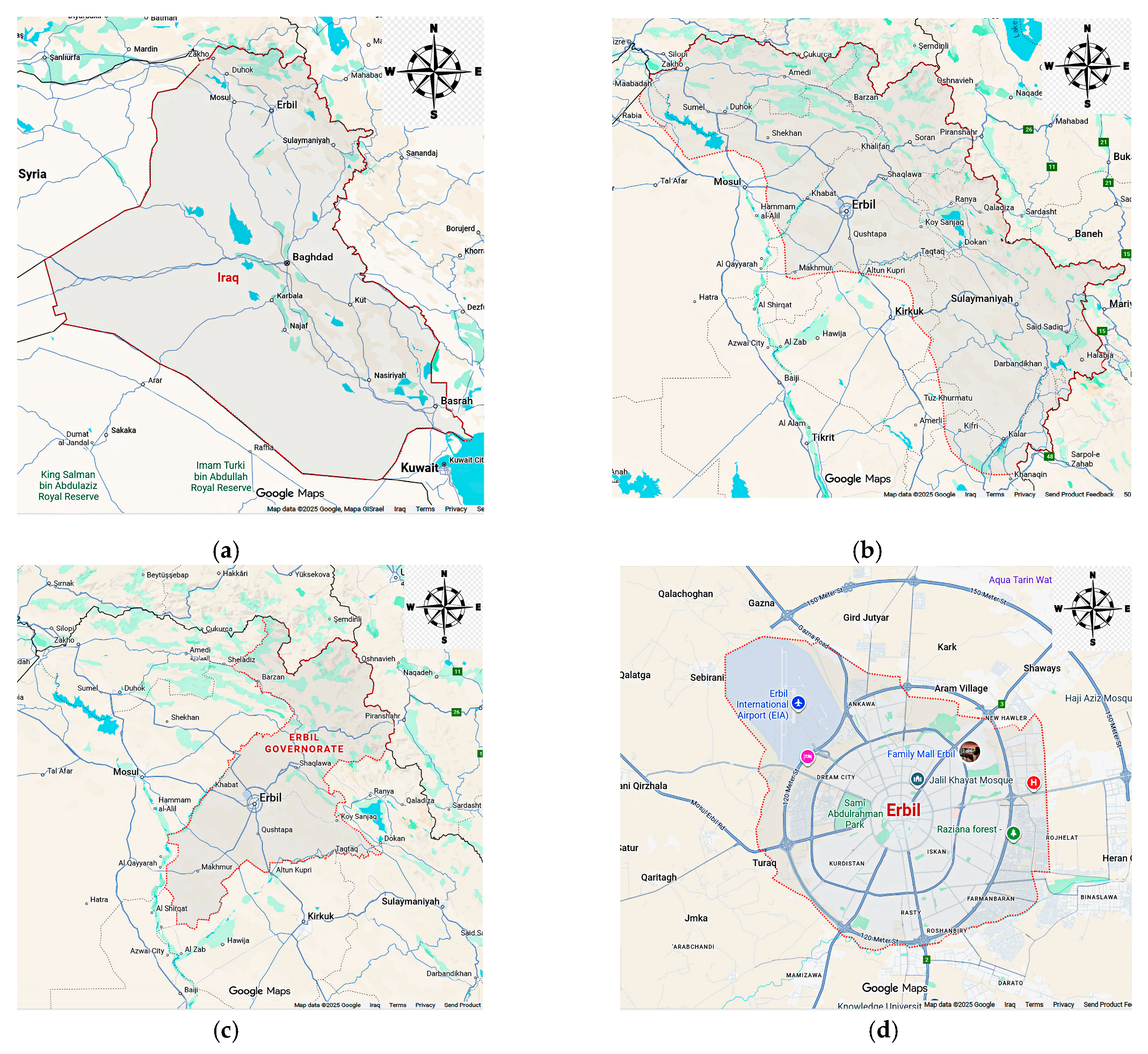
Appendix B
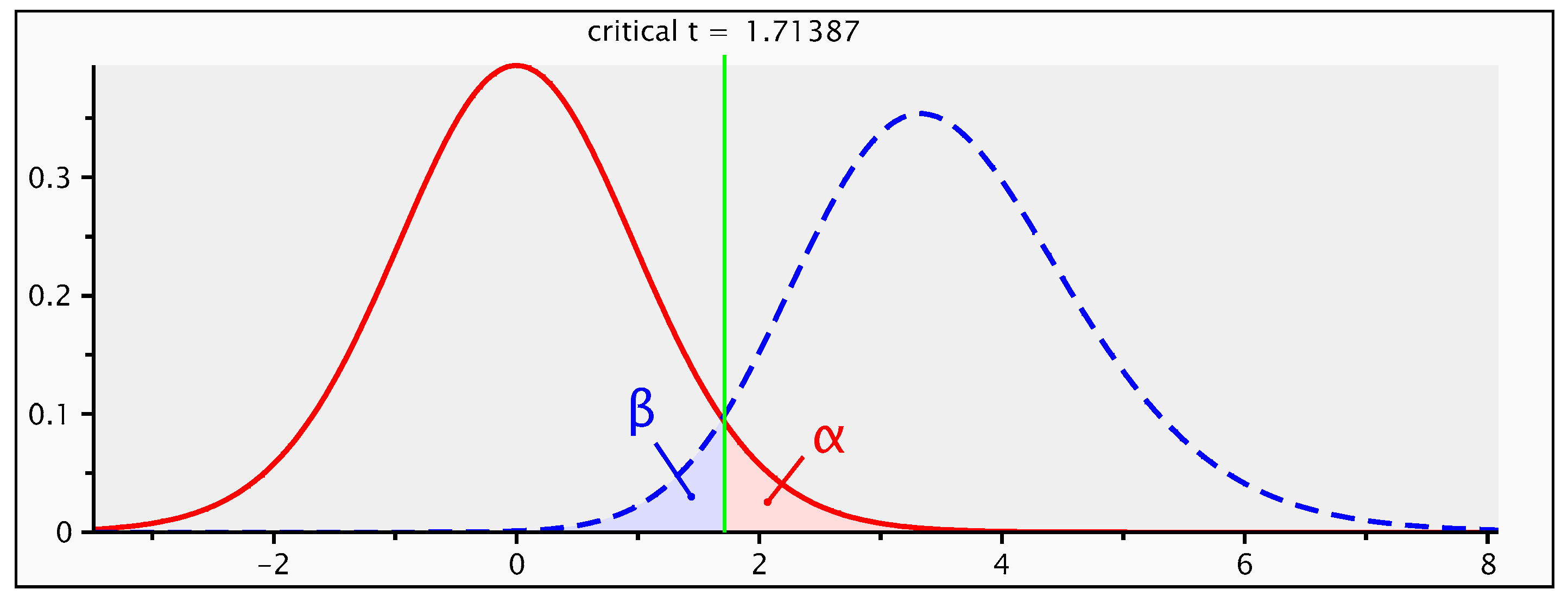
References
- Gracias, J.S.; Parnell, G.S.; Specking, E.; Pohl, E.A.; Buchanan, R. Smart Cities—A Structured Literature Review. Smart Cities 2023, 6, 1719–1743. [Google Scholar] [CrossRef]
- People Centred-Smart Cities | UN-Habitat. Available online: https://unhabitat.org/programme/people-centred-smart-cities (accessed on 10 August 2025).
- People-Centered Smart Cities—UN HABITAT-Flagship Programme.
- Sánchez-Corcuera, R.; Nuñez-Marcos, A.; Sesma-Solance, J.; Bilbao-Jayo, A.; Mulero, R.; Zulaika, U.; Azkune, G.; Almeida, A. Smart Cities Survey: Technologies, Application Domains and Challenges for the Cities of the Future. Int. J. Distrib. Sens. Netw. 2019, 15, 155014771985398. [Google Scholar] [CrossRef]
- Bibri, S.E.; Krogstie, J. A Scholarly Backcasting Approach to a Novel Model for Smart Sustainable Cities of the Future: Strategic Problem Orientation. City Territ. Archit. 2019, 6, 3. [Google Scholar] [CrossRef]
- Schipper, R.; Silvius, A. Characteristics of Smart Sustainable City Development: Implications for Project Management. Smart Cities 2018, 1, 75–97. [Google Scholar] [CrossRef]
- Hara, M.; Nagao, T.; Hannoe, S.; Nakamura, J. New Key Performance Indicators for a Smart Sustainable City. Sustainability 2016, 8, 206. [Google Scholar] [CrossRef]
- Patrão, C.; Moura, P.; Almeida, A.T.D. Review of Smart City Assessment Tools. Smart Cities 2020, 3, 1117–1132. [Google Scholar] [CrossRef]
- Belli, L.; Cilfone, A.; Davoli, L.; Ferrari, G.; Adorni, P.; Di Nocera, F.; Dall’Olio, A.; Pellegrini, C.; Mordacci, M.; Bertolotti, E. IoT-Enabled Smart Sustainable Cities: Challenges and Approaches. Smart Cities 2020, 3, 1039–1071. [Google Scholar] [CrossRef]
- González-Reverté, F. Building Sustainable Smart Destinations: An Approach Based on the Development of Spanish Smart Tourism Plans. Sustainability 2019, 11, 6874. [Google Scholar] [CrossRef]
- Yigitcanlar, T.; Kamruzzaman, M.D.; Buys, L.; Ioppolo, G.; Sabatini-Marques, J.; Da Costa, E.M.; Yun, J.J. Understanding ‘Smart Cities’: Intertwining Development Drivers with Desired Outcomes in a Multidimensional Framework. Cities 2018, 81, 145–160. [Google Scholar] [CrossRef]
- Vinod Kumar, T.M.; Dahiya, B. Smart Economy in Smart Cities. In Smart Economy in Smart Cities; Vinod Kumar, T.M., Ed.; Advances in 21st Century Human Settlements; Springer: Singapore, 2017; pp. 3–76. ISBN 978-981-10-1608-0. [Google Scholar]
- Tekin Bilbil, E. The Operationalizing Aspects of Smart Cities: The Case of Turkey’s Smart Strategies. J. Knowl. Econ. 2017, 8, 1032–1048. [Google Scholar] [CrossRef]
- Depiné, A.; Eleutheriou, V.; Macedo, M. Human Dimension and the Future of Smart Cities. In V International Congress Creative Cities: Proceedings Book. Icon 14 Scientific Association; 2017; pp. 948–957. [Google Scholar]
- Niaros, V. Introducing a Taxonomy of the “Smart City”: Towards a Commons-Oriented Approach? tripleC 2016, 14, 51–61. [Google Scholar] [CrossRef]
- Lara, A.P.; Da Costa, E.M.; Furlani, T.Z.; Yigitcanlar, T. Smartness That Matters: Towards a Comprehensive and Human-Centred Characterisation of Smart Cities. J. Open Innov. Technol. Mark. Complex. 2016, 2, 1–13. [Google Scholar] [CrossRef]
- Al-Nasrawi, S.; Adams, C.; El-Zaart, A. A Conceptual Multidimensional Model for Assessing Smart Sustainable Cities. JISTEM USP 2015, 12, 541–558. [Google Scholar] [CrossRef]
- Mora, L.; Bolici, R. The Development Process of Smart City Strategies: The Case of Barcelona; Juvenes print: Tampere, Finland, 2015. [Google Scholar]
- Piro, G.; Cianci, I.; Grieco, L.A.; Boggia, G.; Camarda, P. Information Centric Services in Smart Cities. J. Syst. Softw. 2014, 88, 169–188. [Google Scholar] [CrossRef]
- Cavada, M.; Rogers, C.; Hunt, D. Smart Cities: Contradicting Definitions and Unclear Measures. In Proceedings of the 4th World Sustainability Forum, Virtual, 1 November 2014; p. f004. [Google Scholar]
- Greco, I.; Bencardino, M. The Paradigm of the Modern City: SMART and SENSEable Cities for Smart, Inclusive and Sustainable Growth. In Proceedings of the Computational Science and Its Applications—ICCSA 2014, Guimaraes, Portugal, 30 June–3 July 2014; Murgante, B., Misra, S., Rocha, A.M.A.C., Torre, C., Rocha, J.G., Falcão, M.I., Taniar, D., Apduhan, B.O., Gervasi, O., Eds.; Lecture Notes in Computer Science. Springer International Publishing: Cham, Germany, 2014; Volume 8580, pp. 579–597, ISBN 978-3-319-09128-0. [Google Scholar]
- Schaffers, H.; Ratti, C.; Komninos, N. Special Issue on Smart Applications for Smart Cities—New Approaches to Innovation: Guest Editors’ Introduction. J. Theor. Appl. Electron. Commer. Res. 2012, 7, 9–10. [Google Scholar] [CrossRef]
- Nam, T.; Pardo, T.A. Conceptualizing Smart City with Dimensions of Technology, People, and Institutions. In Proceedings of the 12th Annual International Digital Government Research Conference: Digital Government Innovation in Challenging Times, College Park, MD, USA, 12–15 June 2011; ACM: College Park, MD, USA, 2011; pp. 282–291. [Google Scholar]
- Zhao, J. Towards Sustainable Cities in China: Analysis and Assessment of Some Chinese Cities in 2008; Springer Science & Business Media: Berlin/Heidelberg, Germany, 2011. [Google Scholar]
- Bull, R.; Azennoud, M. Smart Citizens for Smart Cities: Participating in the Future. Proc. Inst. Civ. Eng.-Energy 2016, 169, 93–101. [Google Scholar] [CrossRef]
- Kaneti, V.R.; Yamini, B.; Nagarajan, S.; Adaikkammai, A.; Anto Gracious, L.A.; Siva Subramanian, R.; Girija, P. Smart Transportation Systems and Sustainable Urban Mobility. In Revolutionizing Urban Development and Governance with Emerging Technologies; Al Maqousi, A., Almomani, A., Aldweesh, A., Alauthman, M., Eds.; IGI Global: Hershey, PA, USA, 2025; pp. 261–288. ISBN 979-8-3373-1375-7. [Google Scholar]
- Ansari, M.S.H.; Farooqui, N.A.; Ishrat, M.; Khan, W. IoT Applications in Urban Infrastructure and Governance. In Revolutionizing Urban Development and Governance with Emerging Technologies; Al Maqousi, A., Almomani, A., Aldweesh, A., Alauthman, M., Eds.; IGI Global: Hershey, PA, USA, 2025; pp. 343–386. ISBN 979-8-3373-1375-7. [Google Scholar]
- Bellini, P.; Nesi, P.; Pantaleo, G. IoT-Enabled Smart Cities: A Review of Concepts, Frameworks and Key Technologies. Appl. Sci. 2022, 12, 1607. [Google Scholar] [CrossRef]
- Drepaul, N. Sustainable Cities and the Internet of Things (IOT) Technology. Consilience 2020, 22, 39–47. [Google Scholar] [CrossRef]
- McKenna, H. Human-Smart Environment Interactions in Smart Cities: Exploring Dimensionalities of Smartness. Future Internet 2020, 12, 79. [Google Scholar] [CrossRef]
- Myeong, S.; Jung, Y.; Lee, E. A Study on Determinant Factors in Smart City Development: An Analytic Hierarchy Process Analysis. Sustainability 2018, 10, 2606. [Google Scholar] [CrossRef]
- Hunter, G.W.; Vettorato, D.; Sagoe, G. Creating Smart Energy Cities for Sustainability through Project Implementation: A Case Study of Bolzano, Italy. Sustainability 2018, 10, 2167. [Google Scholar] [CrossRef]
- Papa, R.; Gargiulo, C.; Galderisi, A. Towards an Urban Planners’ Perspective on Smart City. TeMA 2013, 6, 5–17. [Google Scholar]
- Komninos, N. The Architecture of Intelligent Cities: Integrating Human, Collective and Artificial Intelligence to Enhance Knowledge and Innovation. In Proceedings of the 2006 2nd IET International Conference on Intelligent Environments-IE 06, Athens, Greece, 5–6 July 2006; Volume 1, pp. 13–20. [Google Scholar]
- Lindskog, H. Smart Communities Initiatives. In Proceedings of the 3rd ISOneWorld Conference, Las Vegas, NV, USA, 14–16 April 2004; Volume 16, pp. 14–16. [Google Scholar]
- De Jong, M.; Joss, S.; Schraven, D.; Zhan, C.; Weijnen, M. Sustainable–Smart–Resilient–Low Carbon–Eco–Knowledge Cities; Making Sense of a Multitude of Concepts Promoting Sustainable Urbanization. J. Clean. Prod. 2015, 109, 25–38. [Google Scholar] [CrossRef]
- Gupta, S.; Ziaul Mustafa, S.; Kumar, H. Smart People for Smart Cities: A Behavioral Framework for Personality and Roles. In Advances in Smart Cities; Kar, A.K., Gupta, M.P., Vigneswara Ilavarasan, P., Dwivedi, Y.K., Eds.; Chapman and Hall/CRC: Boca Raton, FL, USA, 2017; pp. 23–30. ISBN 978-1-315-15604-0. [Google Scholar]
- Landa Oregi, I.; Gonzalez Ochoantesana, I.; Anaya Rodriguez, M. Understanding the Engagement of Citizens in the Regeneration of Urban Spaces Through Human-Centered Design: A Systematic Literature Review. Cities 2025, 168, 106414. [Google Scholar] [CrossRef]
- Wang, R.; Huang, C.; Ye, Y. Measuring Street Quality: A Human-Centered Exploration Based on Multi-Sourced Data and Classical Urban Design Theories. Buildings 2024, 14, 3332. [Google Scholar] [CrossRef]
- Chang, S.; Smith, M.K. Residents’ Quality of Life in Smart Cities: A Systematic Literature Review. Land 2023, 12, 876. [Google Scholar] [CrossRef]
- Calzada, I. The Right to Have Digital Rights in Smart Cities. Sustainability 2021, 13, 11438. [Google Scholar] [CrossRef]
- Xu, H.; Geng, X. People-Centric Service Intelligence for Smart Cities. Smart Cities 2019, 2, 135–152. [Google Scholar] [CrossRef]
- Alverti, M.N.; Themistocleous, K.; Kyriakidis, P.C.; Hadjimitsis, D.G. A Human Centric Approach on the Analysis of the Smart City Concept: The Case Study of the Limassol City in Cyprus. Adv. Geosci. 2018, 45, 305–320. [Google Scholar] [CrossRef]
- Allam, Z.; Newman, P. Redefining the Smart City: Culture, Metabolism and Governance. Smart Cities 2018, 1, 4–25. [Google Scholar] [CrossRef]
- Albino, V.; Berardi, U.; Dangelico, R.M. Smart Cities: Definitions, Dimensions, Performance, and Initiatives. J. Urban Technol. 2015, 22, 3–21. [Google Scholar] [CrossRef]
- Agee, P.; Gao, X.; Paige, F.; McCoy, A.; Kleiner, B. A Human-Centred Approach to Smart Housing. Build. Res. Inf. 2021, 49, 84–99. [Google Scholar] [CrossRef]
- Maqousi, A.; Basu, K.; Almomani, A.; Alkasassbeh, M. Human-Centered Design for Smart Cities: Integrating Social Aspects in Planning and Policy. In Revolutionizing Urban Development and Governance with Emerging Technologies; Al Maqousi, A., Almomani, A., Aldweesh, A., Alauthman, M., Eds.; IGI Global: Hershey, PA, USA, 2025; pp. 463–490. ISBN 979-8-3373-1375-7. [Google Scholar]
- Bosch, P.; Jongeneel, S.; Rovers, V.; Neumann, H.-M.; Huovila, A. CITYkeys Indicators for Smart City Projects and Smart Cities. CITYkeys Rep. 2017, 10, 2027. [Google Scholar]
- Ishaq Bhatti, M.; Awan, H.M.; Razaq, Z. The Key Performance Indicators (KPIs) and Their Impact on Overall Organizational Performance. Qual. Quant. 2014, 48, 3127–3143. [Google Scholar] [CrossRef]
- Higher Committee for Erbil Citadel Revival (HCECR) Planning Areas of The Buffer Zone of The Erbil Citadel 2024.
- Higher Committee for Erbil Citadel Revival (HCECR); United Nations Planning and Construction Regulations for the Buffer Zone of Erbil Citadel 2013.
- depthMapX Space Syntax—Online Training Platform. Available online: https://www.spacesyntax.online/software-and-manuals/depthmap/ (accessed on 10 August 2025).
- Fladd, S.G. Social Syntax: An Approach to Spatial Modification through the Reworking of Space Syntax for Archaeological Applications. J. Anthr. Archaeol. 2017, 47, 127–138. [Google Scholar] [CrossRef]
- Software Space Syntax Network. Available online: https://www.spacesyntax.net/software/ (accessed on 10 August 2025).
- Pinelo, J.; Turner, A. Introduction to Depthmap; UCL: London, UK, 2010. [Google Scholar]
- Turner, A. Depthmap 4—A Researcher’s Handbook; UCL School of Graduate Studies: London, UK, 2004. [Google Scholar]
- van Nes, A.; Yamu, C. Introduction to Space Syntax in Urban Studies; Springer Nature: Norway, The Netherlands, 2023; ISBN 978-3-030-59139-7. [Google Scholar]
- Matejcek, J.; Pribyl, O. Space Syntax: A Multi-Disciplinary Tool to Understand City Dynamics. In Proceedings of the 2020 Smart City Symposium Prague (SCSP), Virtual, 25 June 2020; IEEE: Prague, Czech Republic, 2020; pp. 1–6. [Google Scholar]
- Hillier, B.; Hanson, J. The Social Logic of Space, 1st ed.; Cambridge University Press: Cambridge, UK, 1984; ISBN 13 978-0-521-23365-1. [Google Scholar]
- Hillier, B.; Burdett, R.; Peponis, J.; Penn, A. Creating Life: Or, Does Architecture Determine Anything? Available online: https://discovery.ucl.ac.uk/id/eprint/101/ (accessed on 10 August 2025).
- Esposito, D.; Santoro, S.; Camarda, D. Agent-Based Analysis of Urban Spaces Using Space Syntax and Spatial Cognition Approaches: A Case Study in Bari, Italy. Sustainability 2020, 12, 4625. [Google Scholar] [CrossRef]
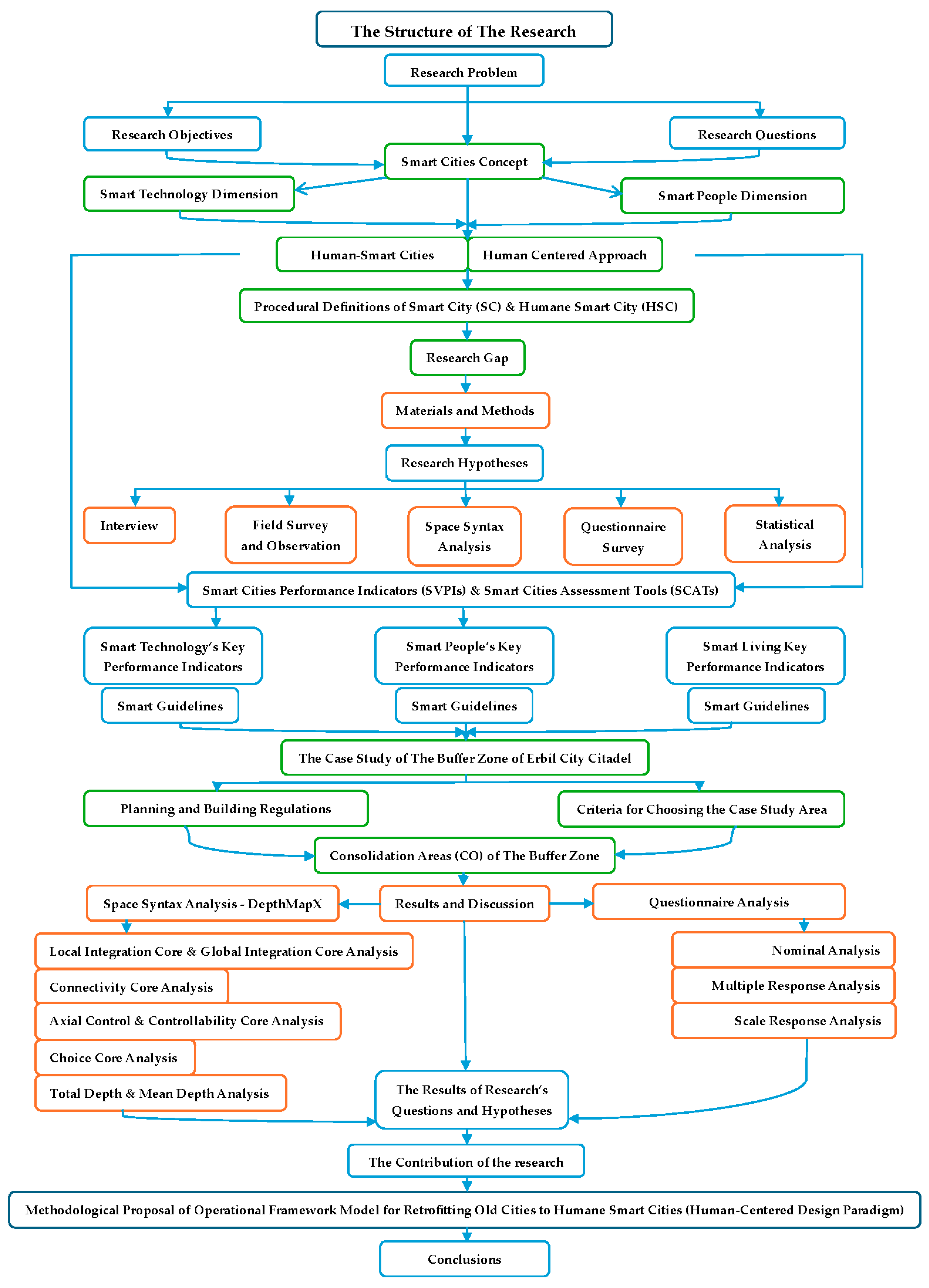
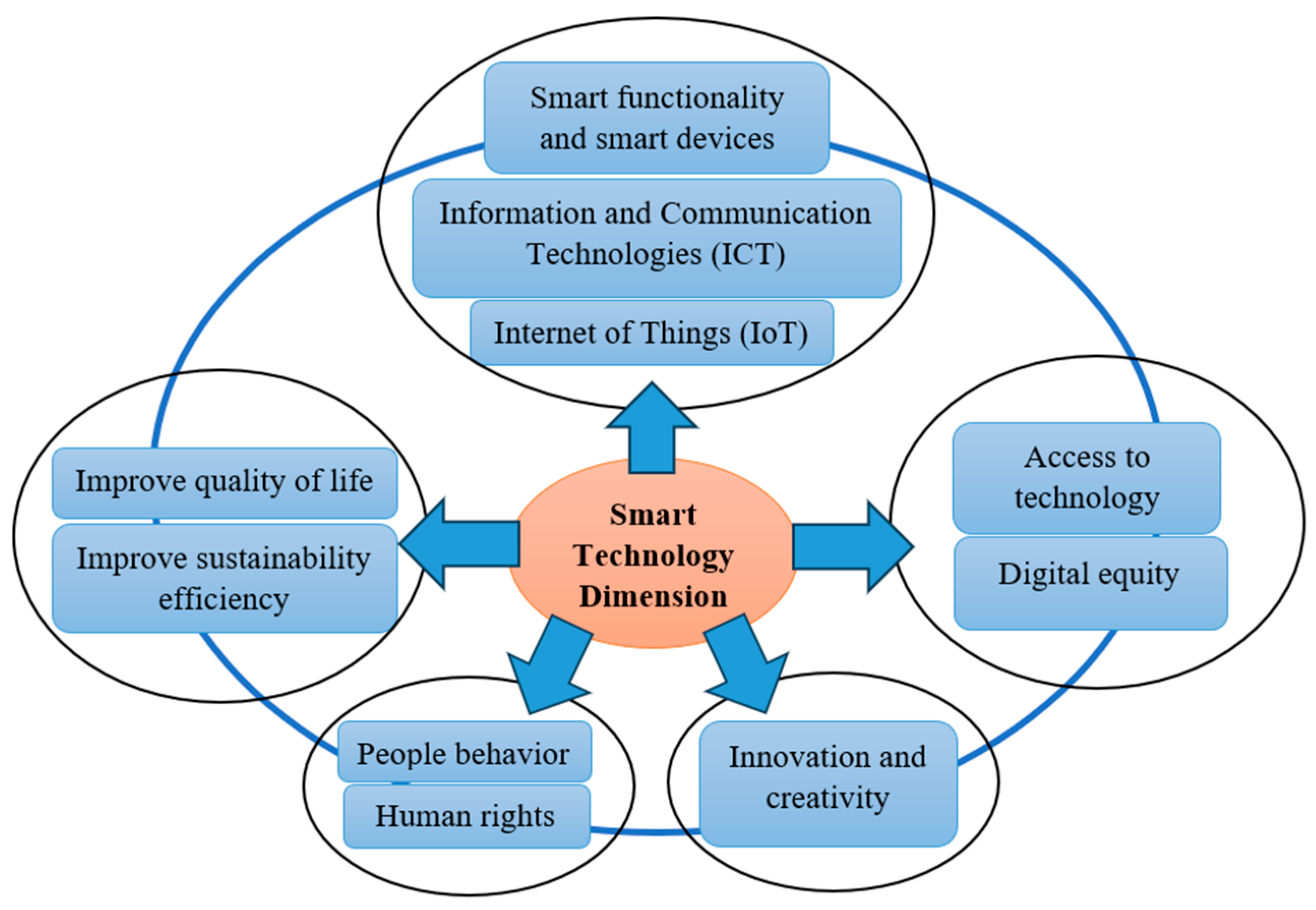
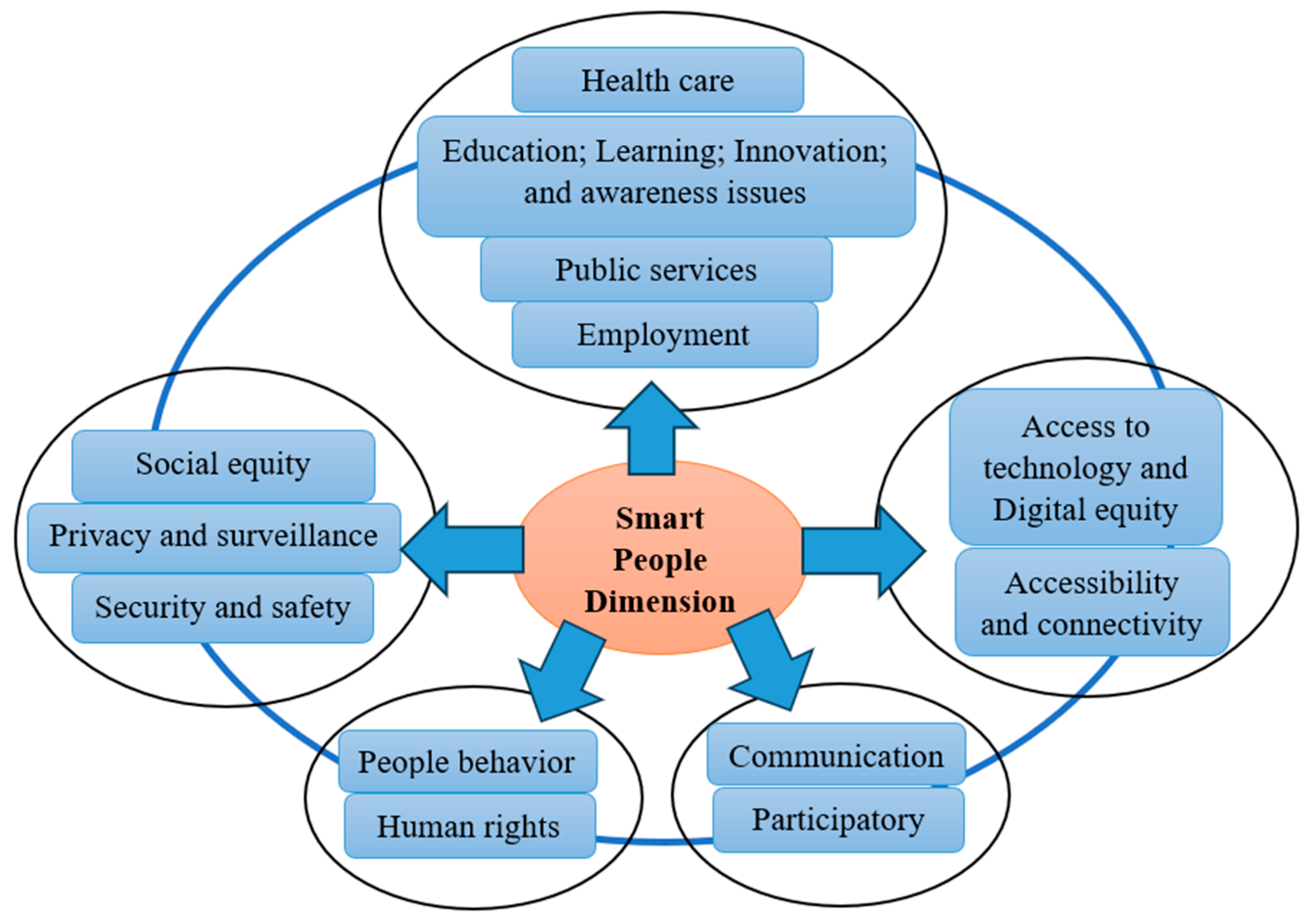
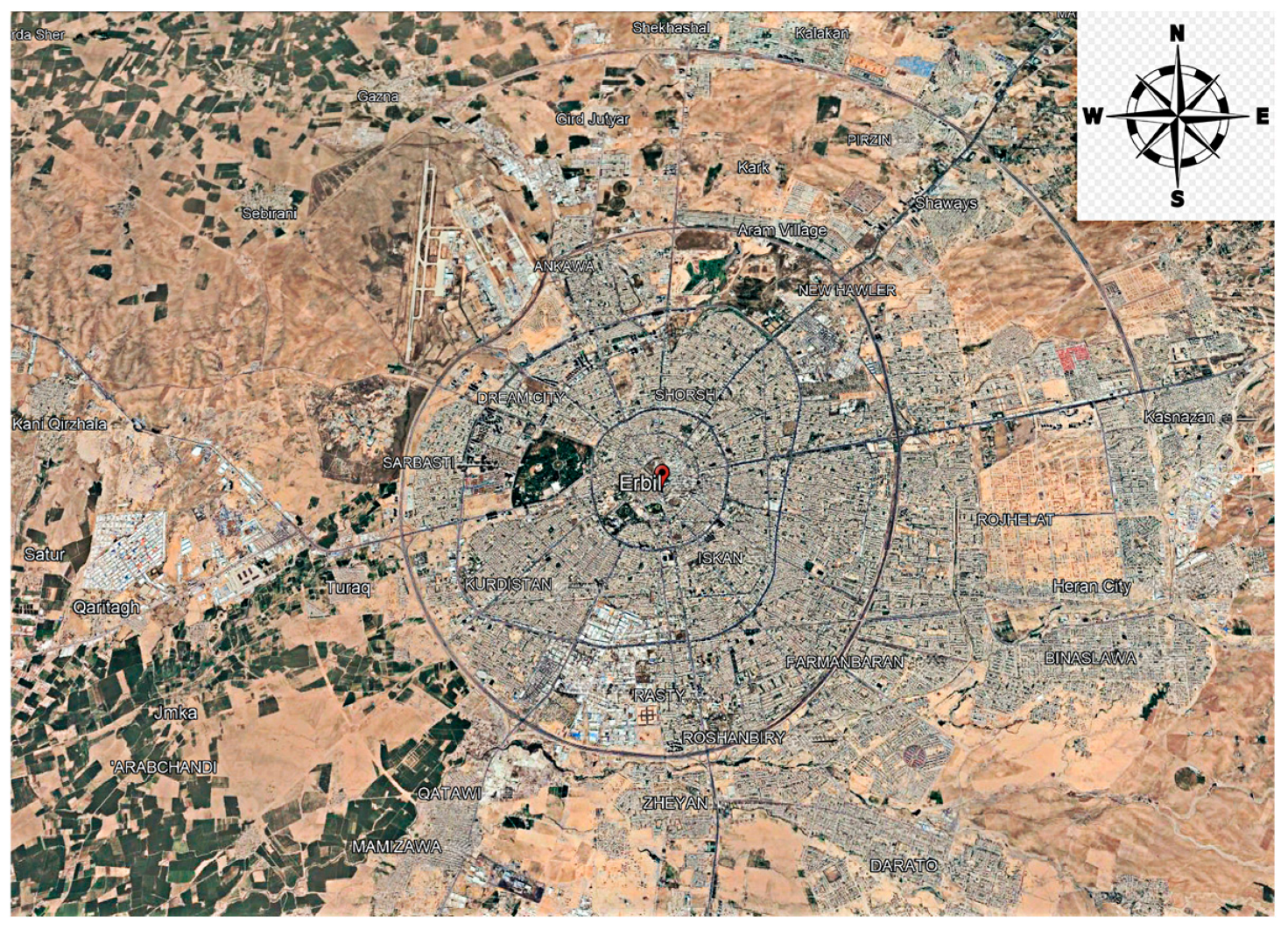
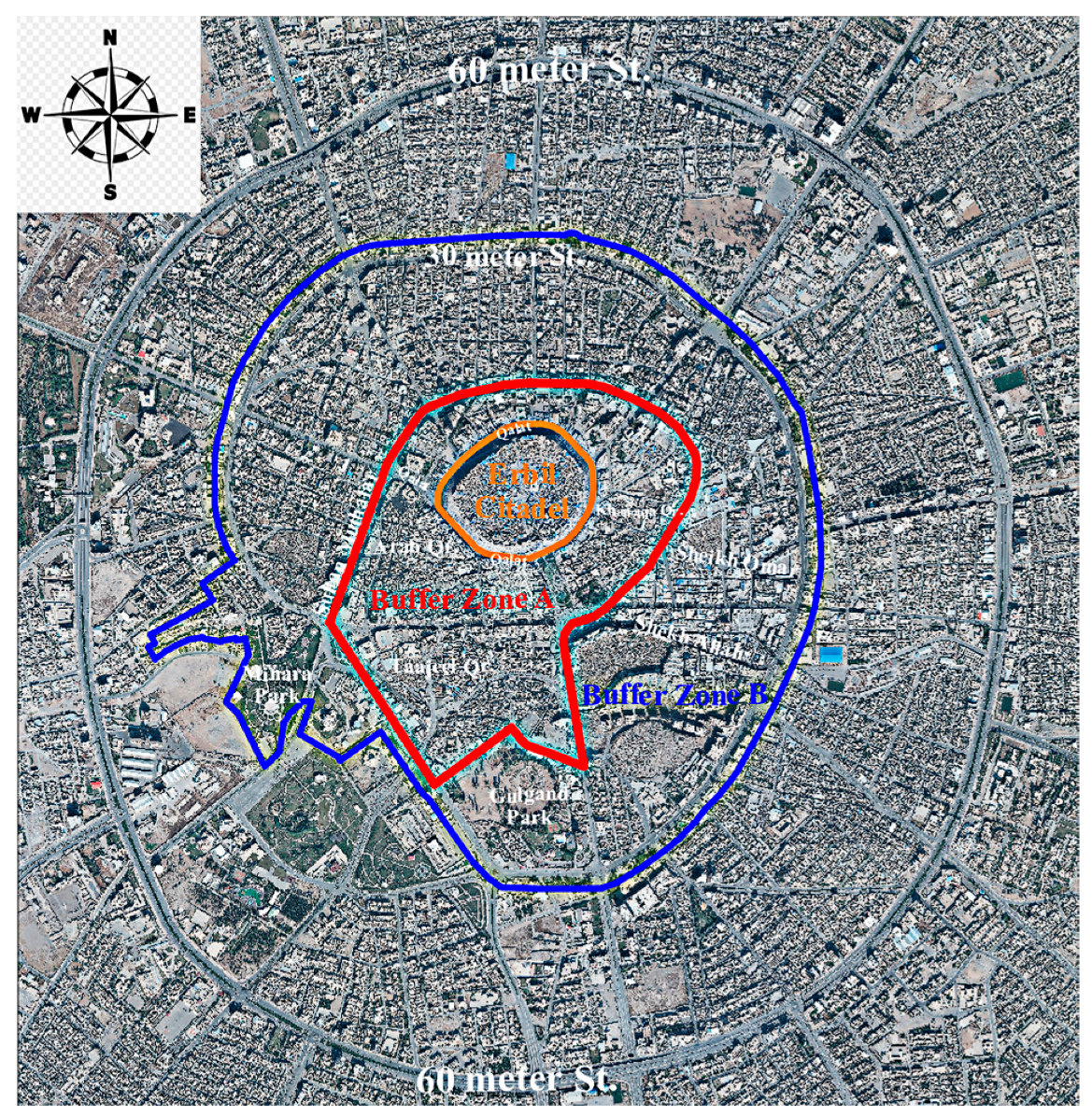
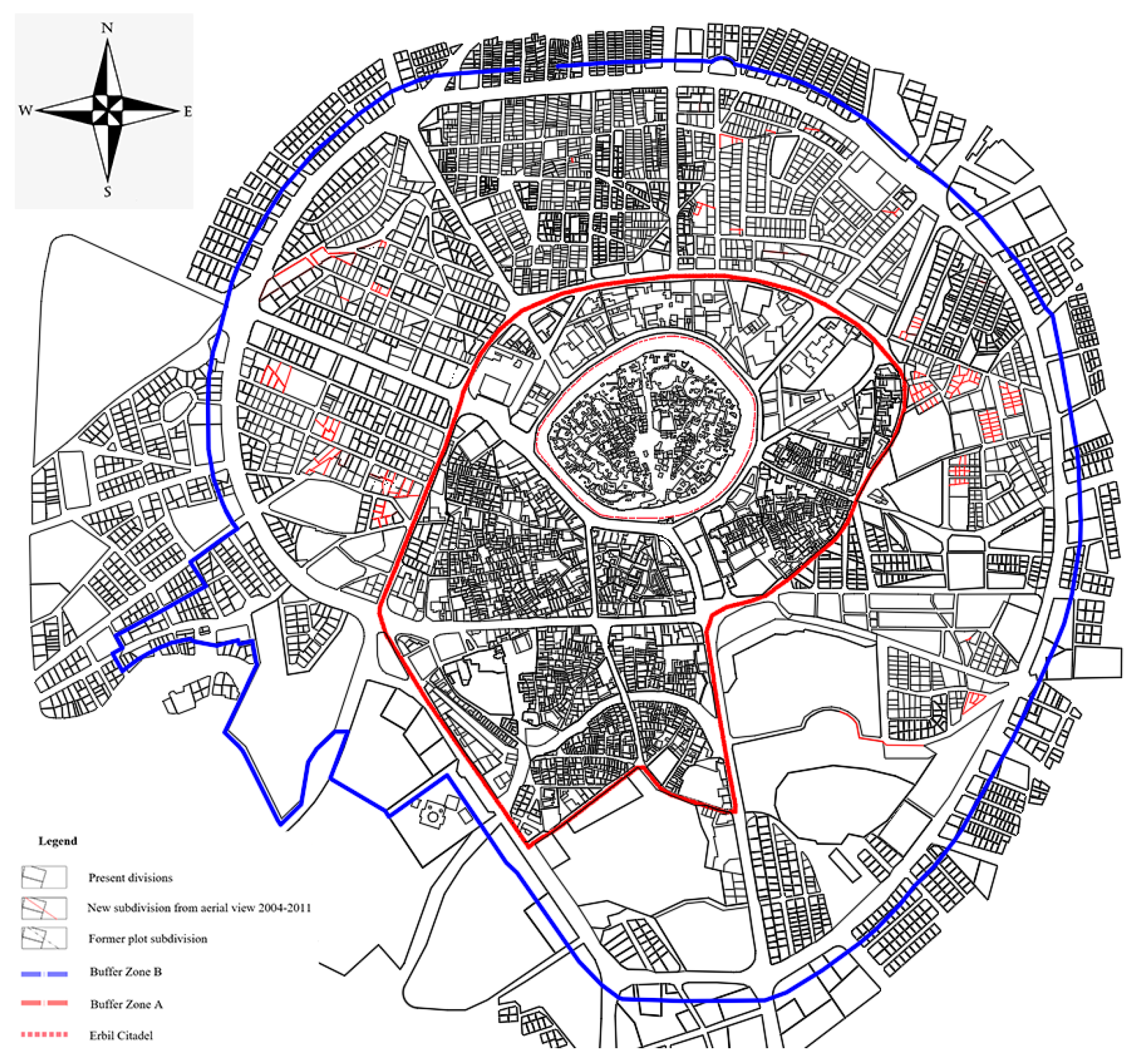
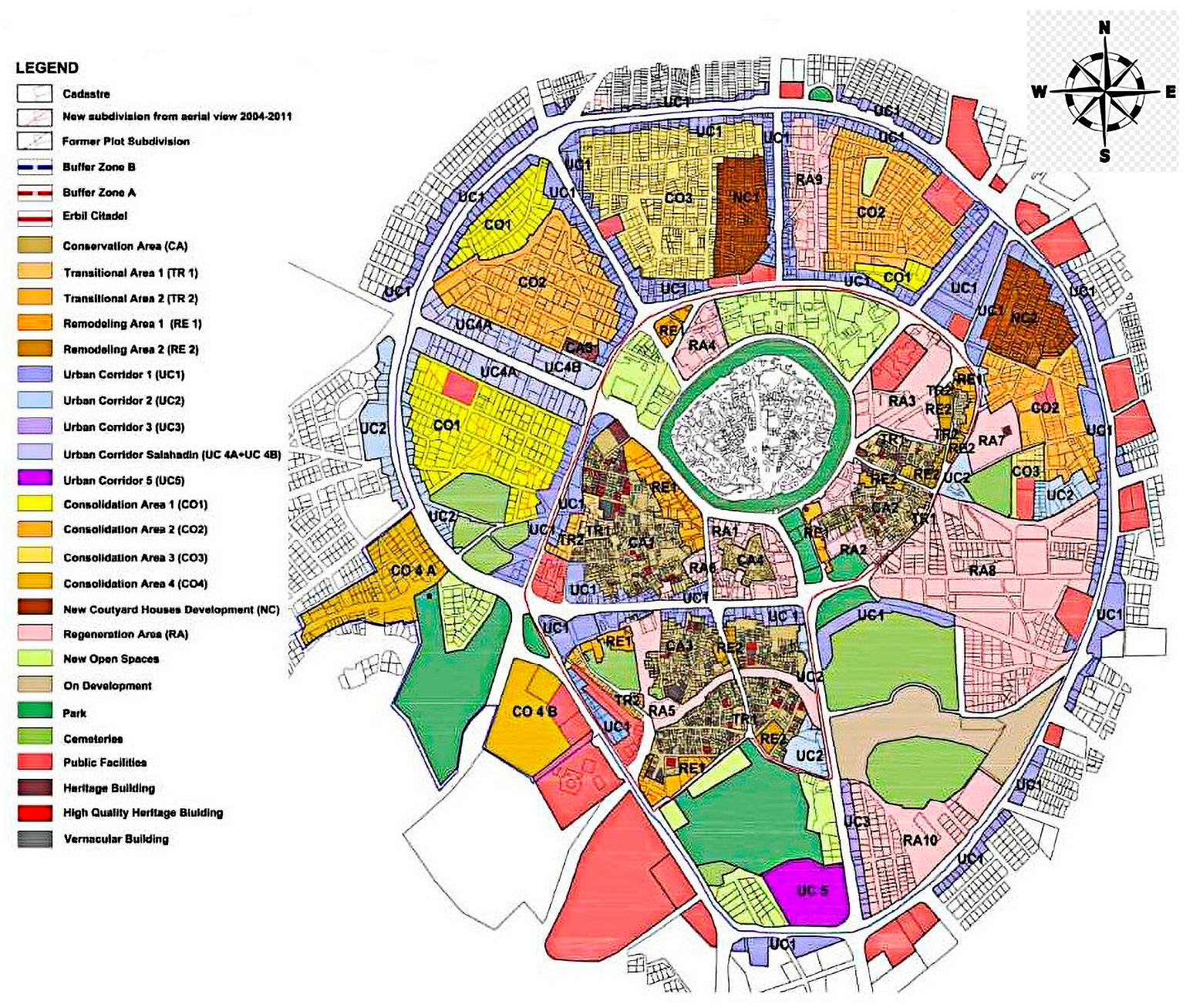
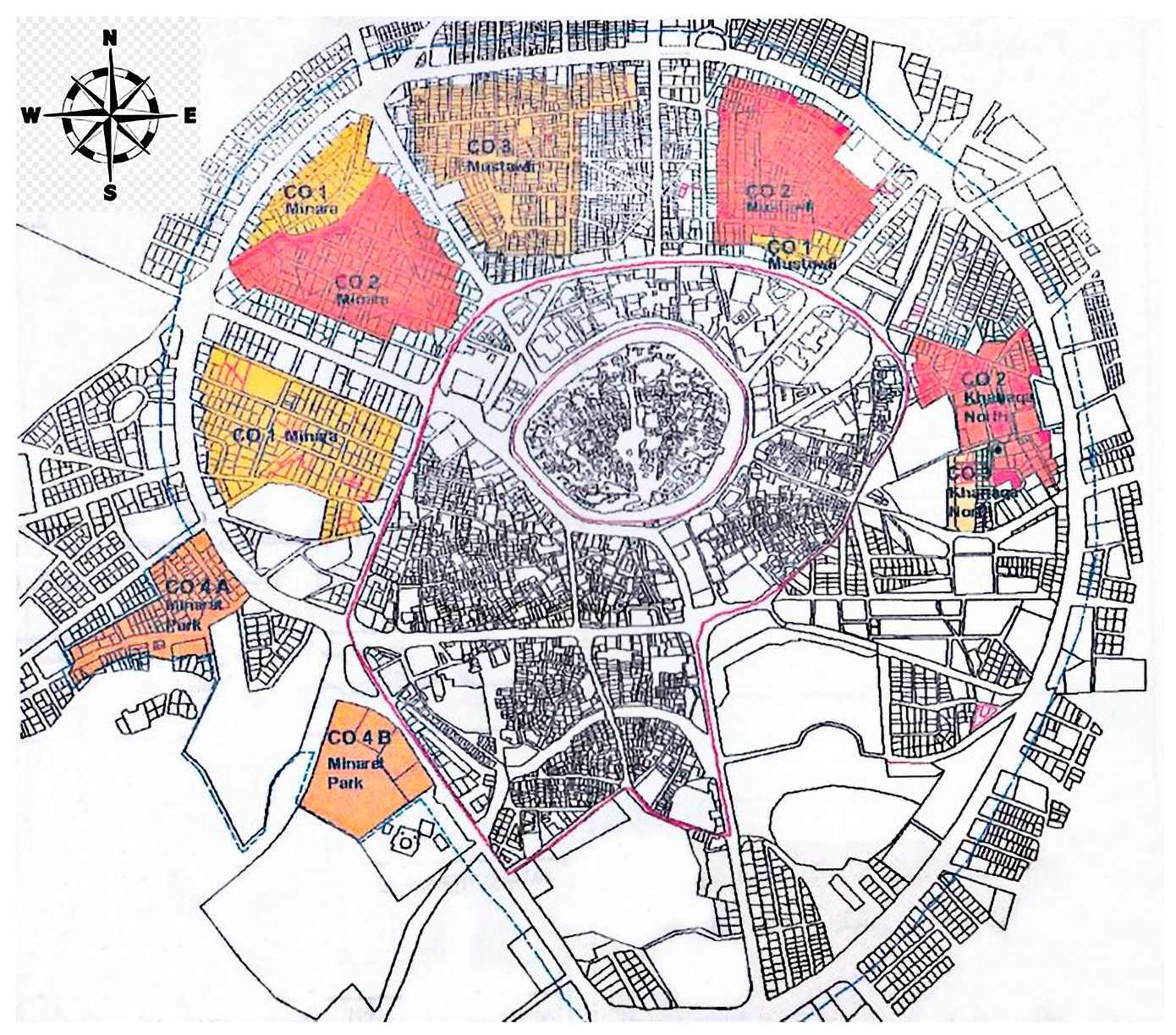

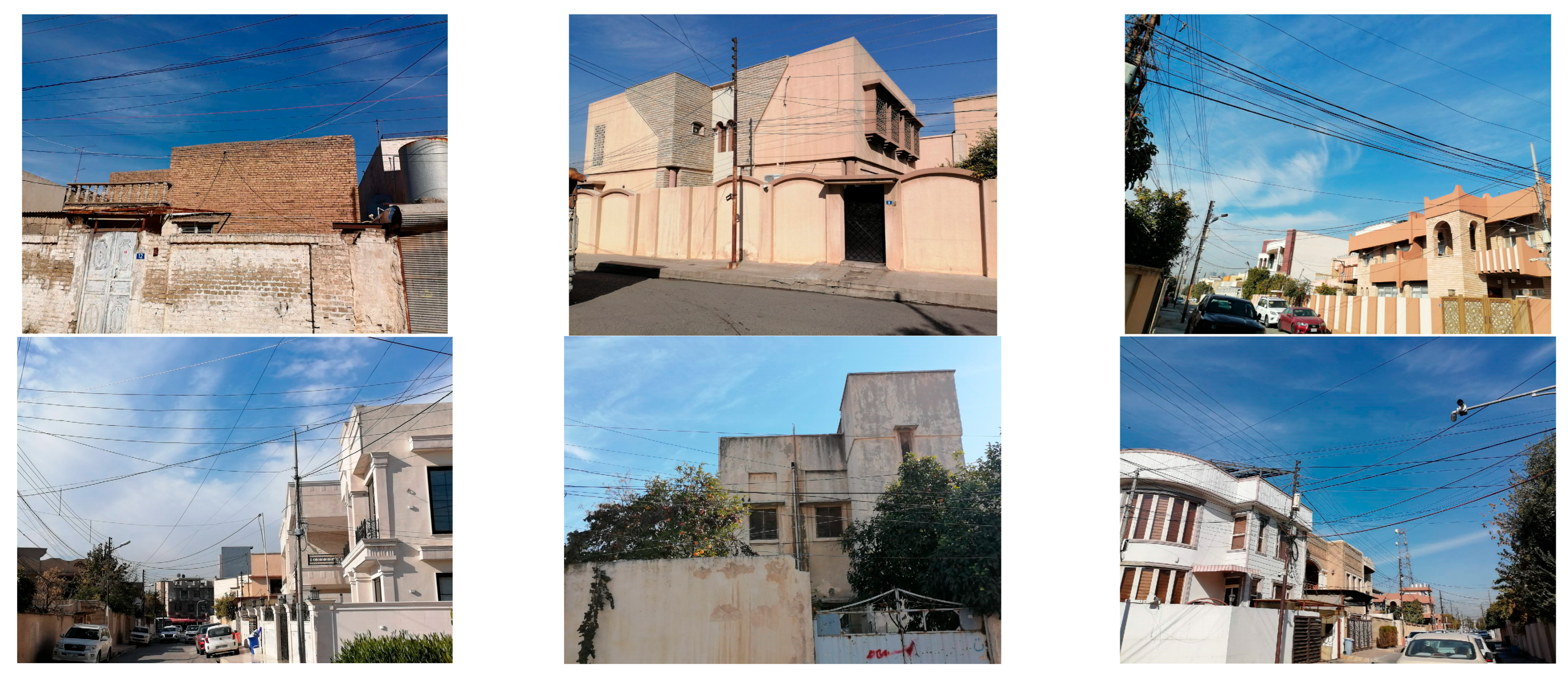
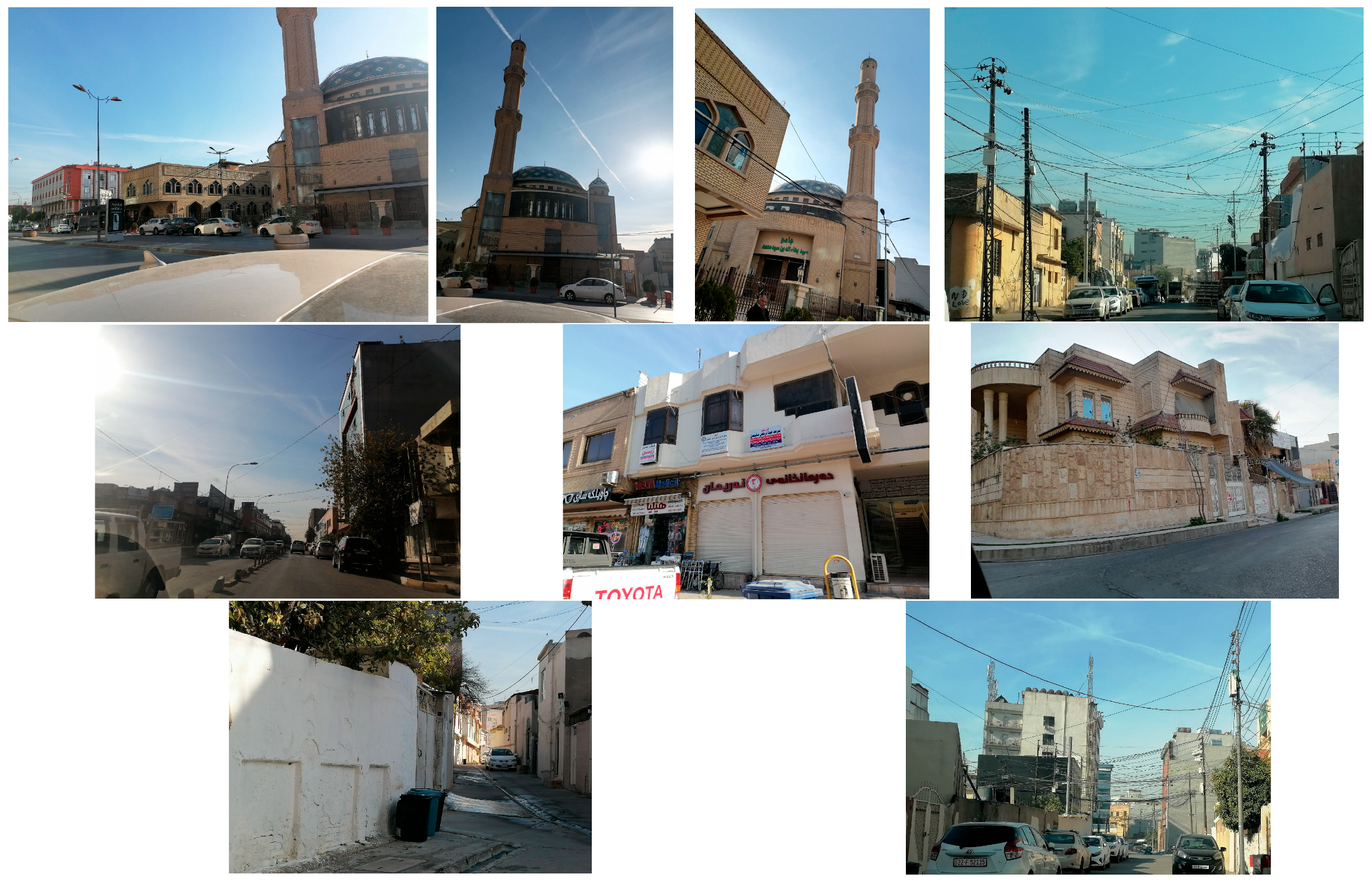

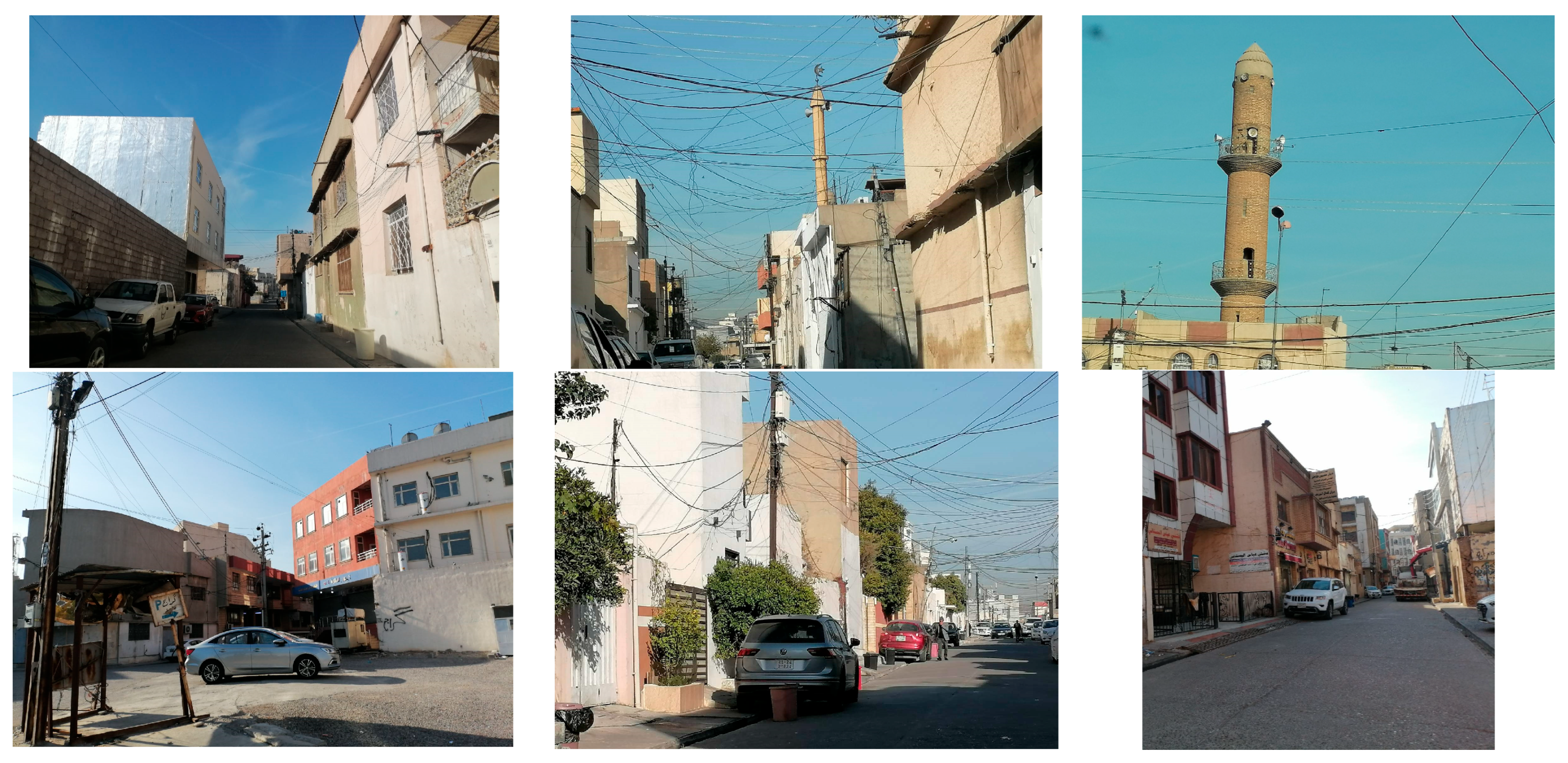
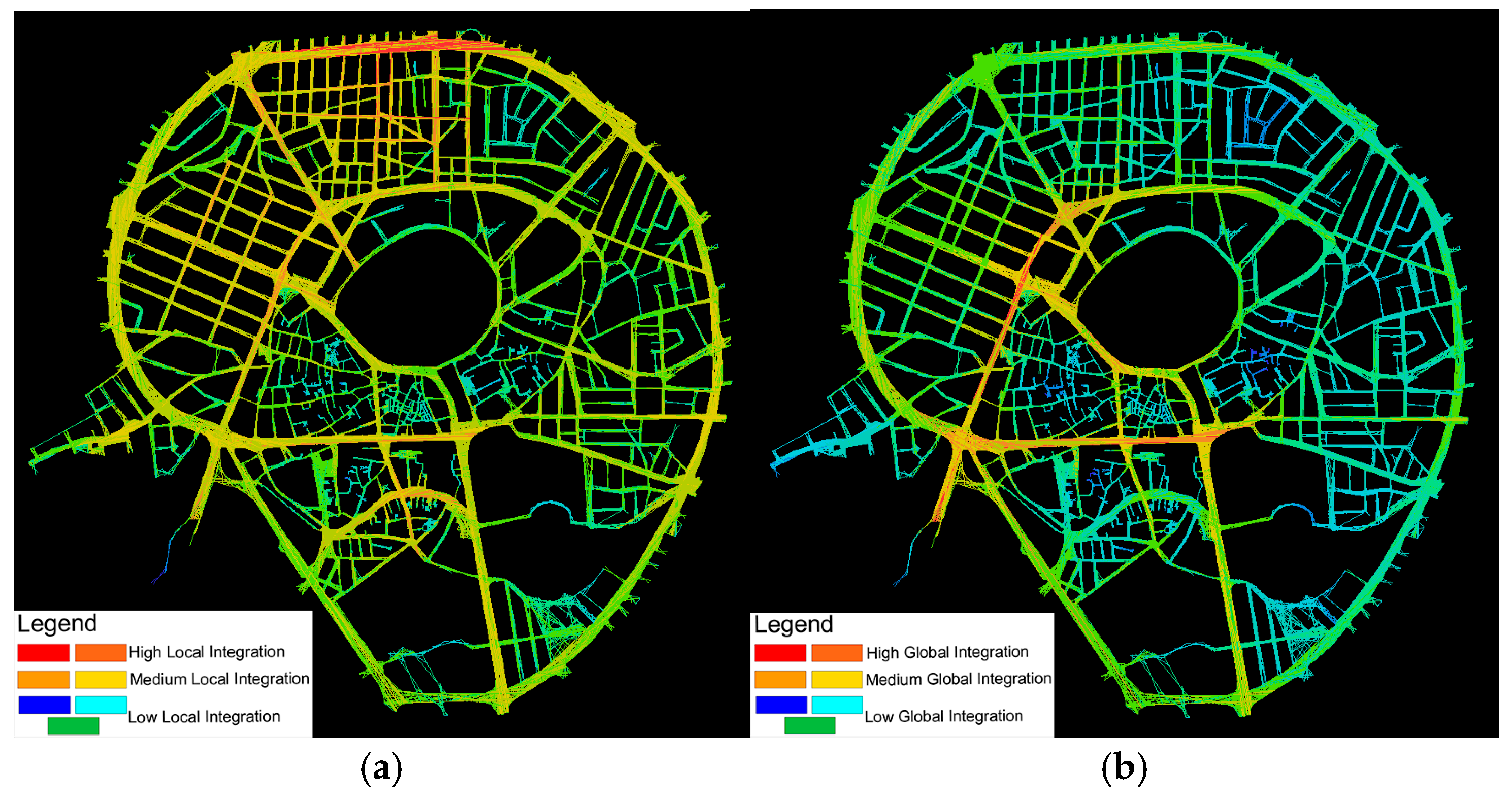
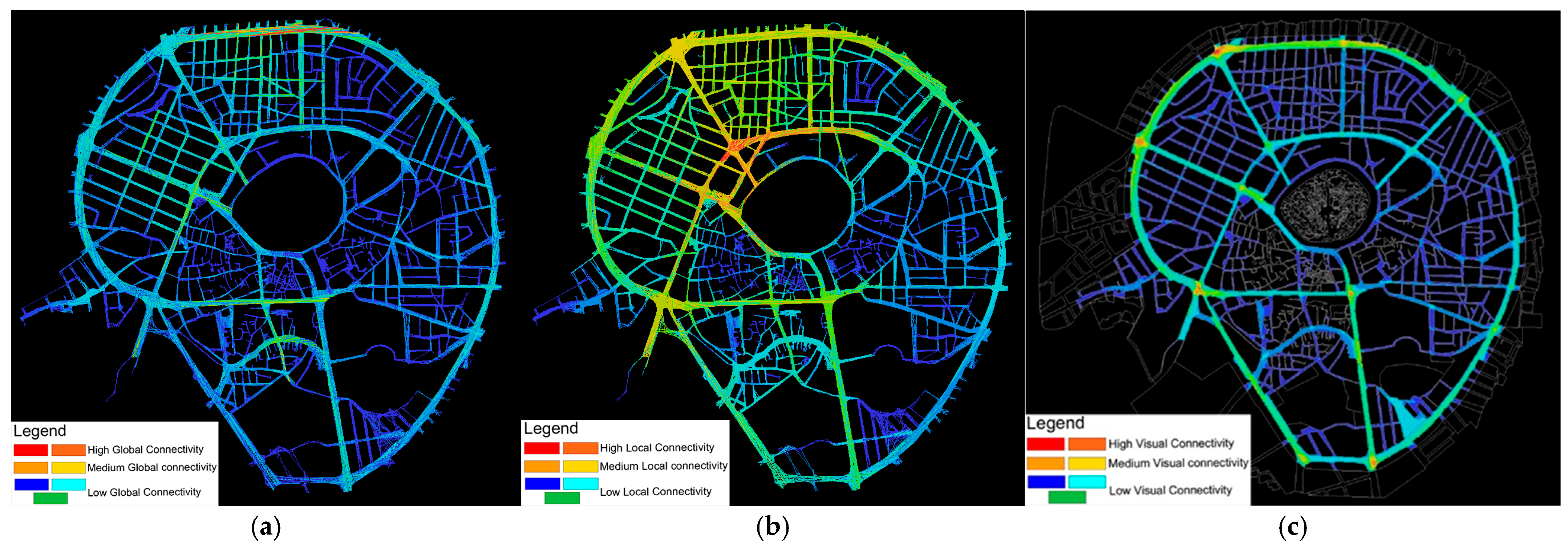
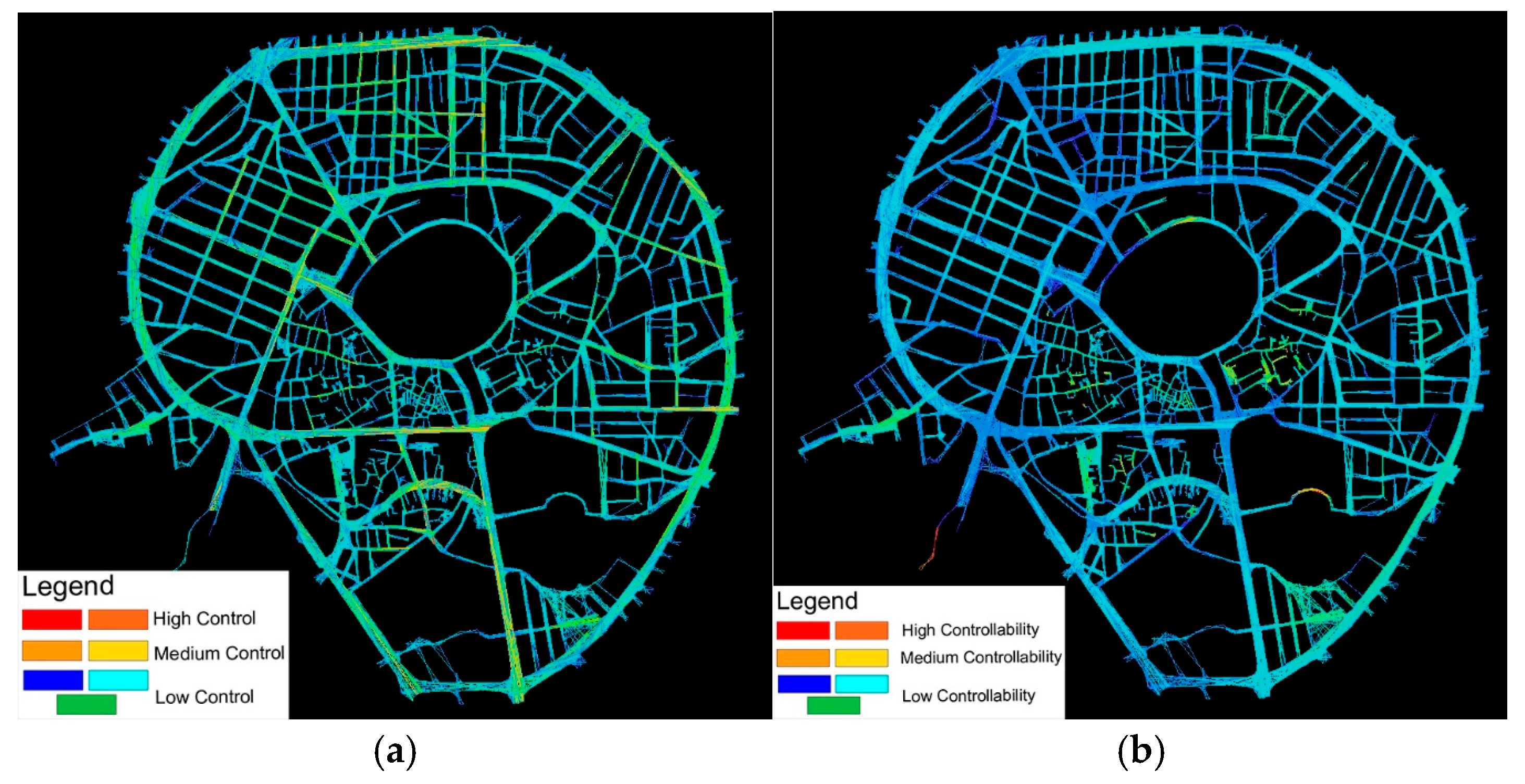
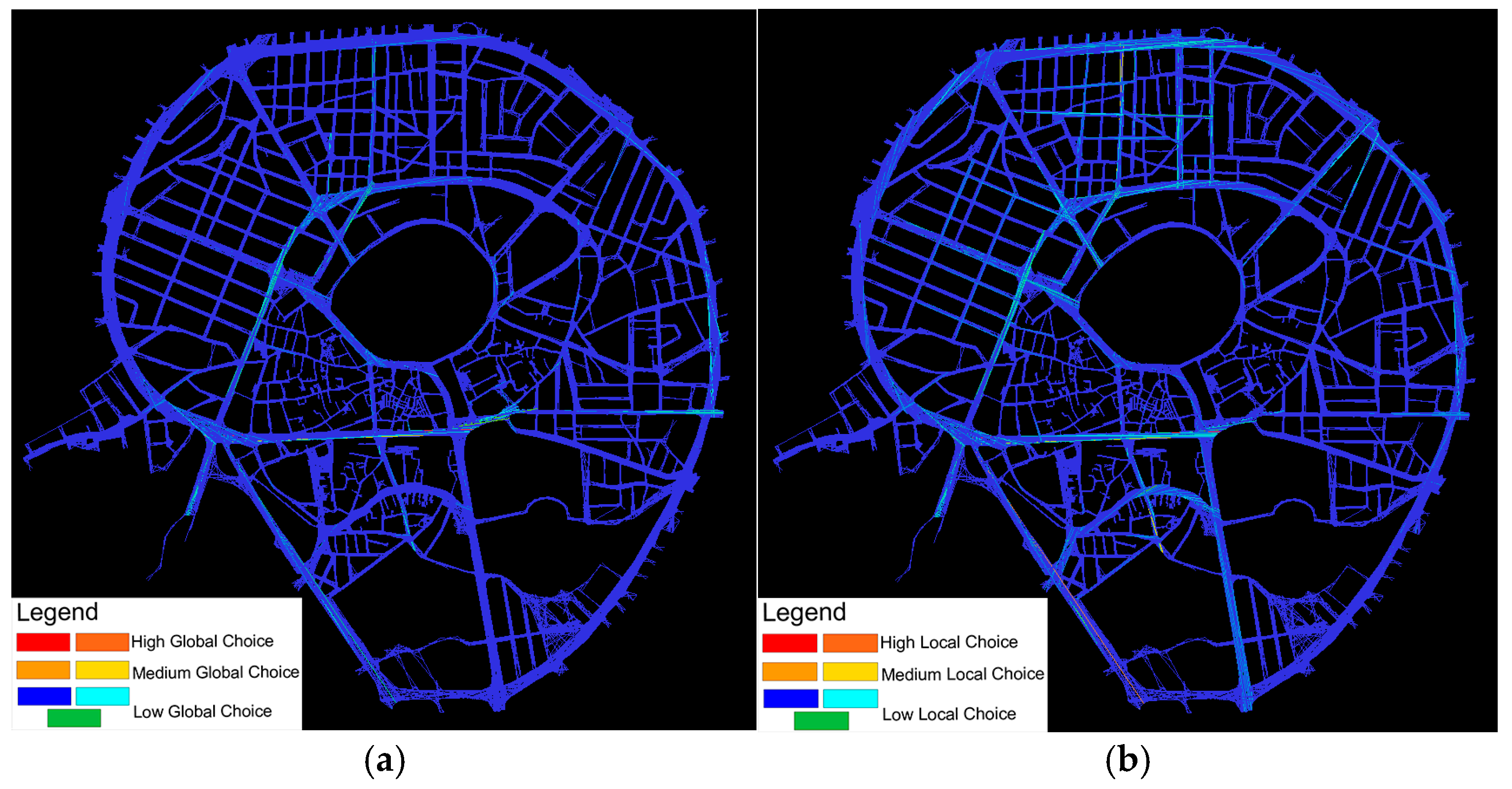
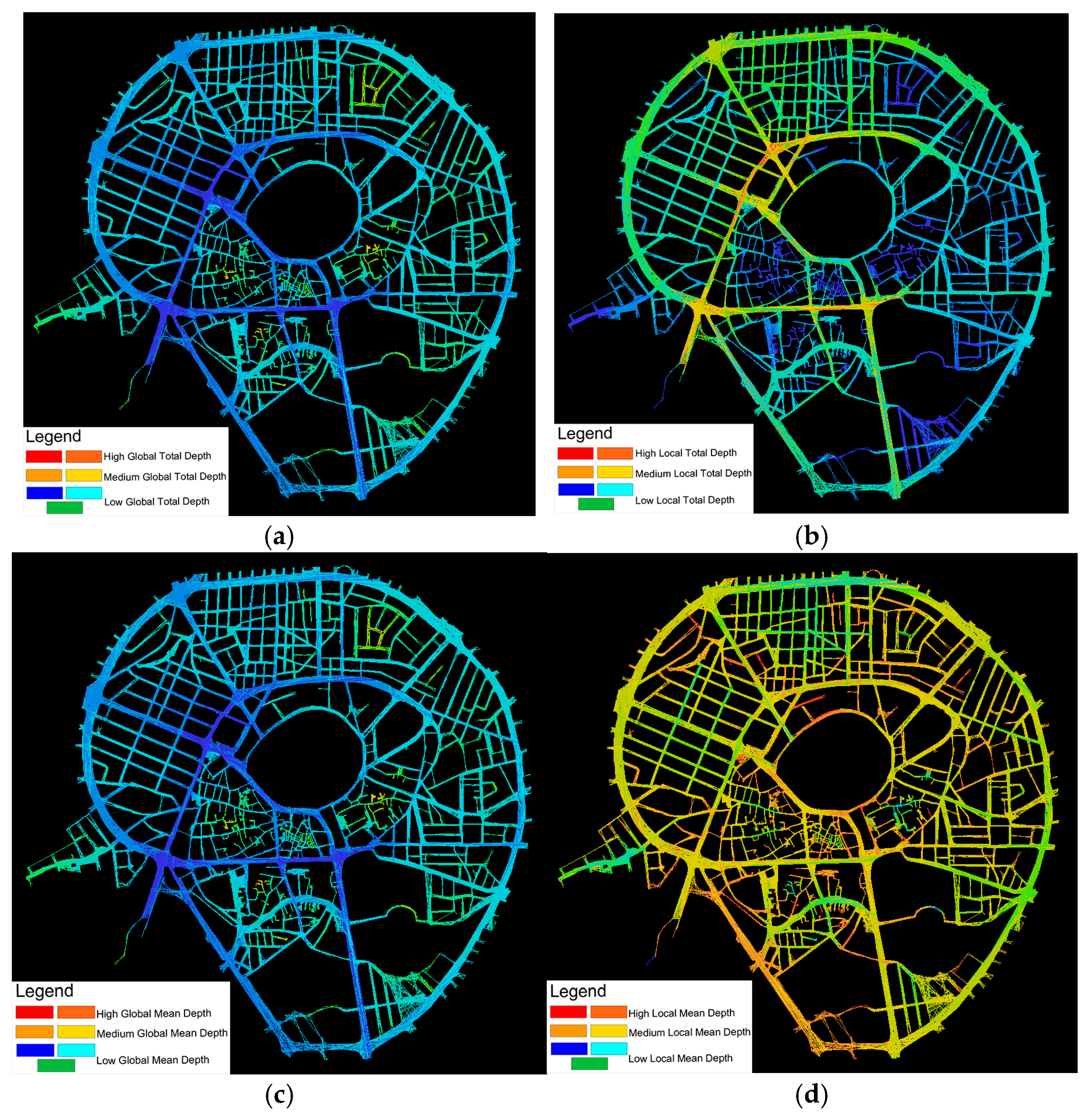
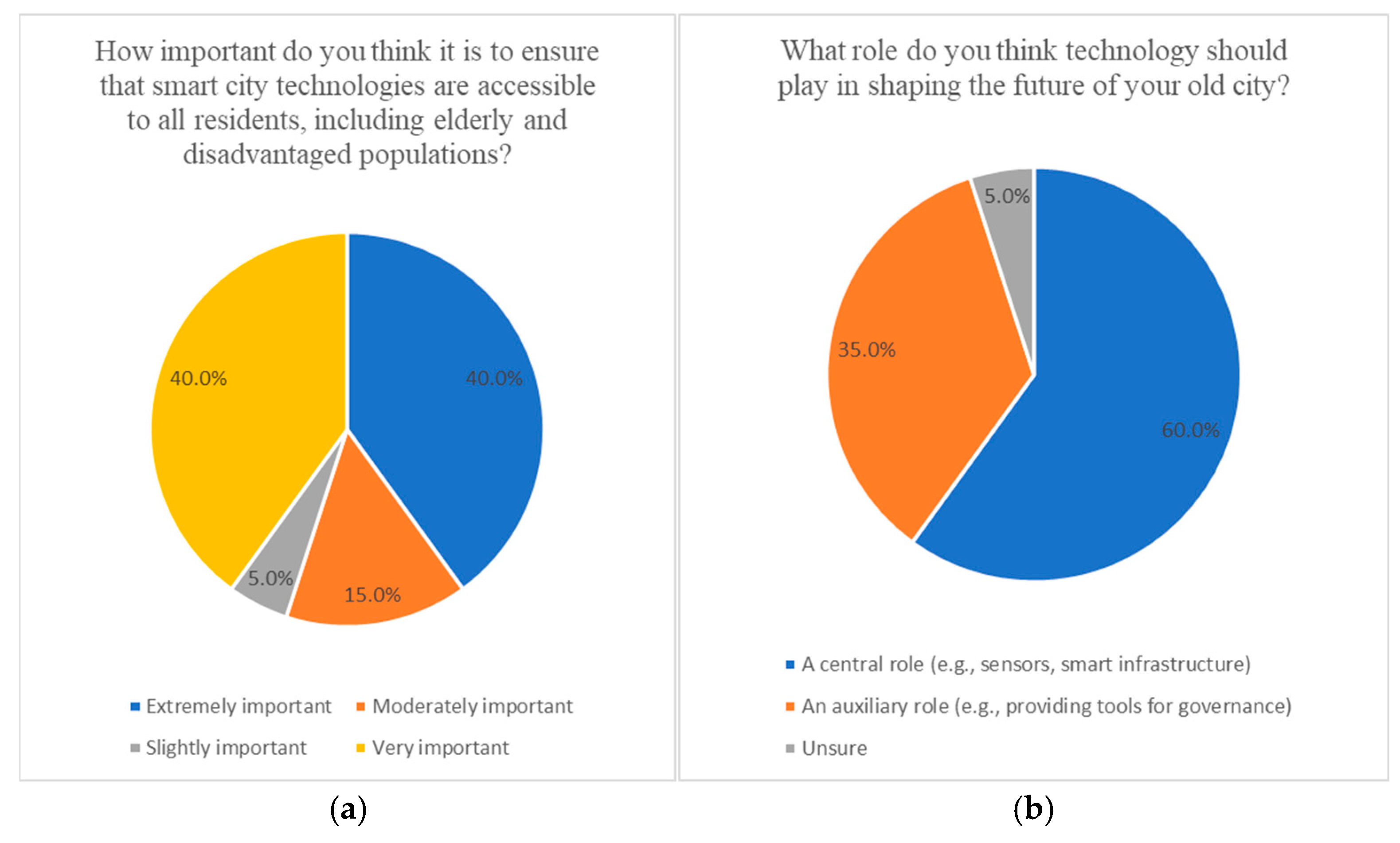
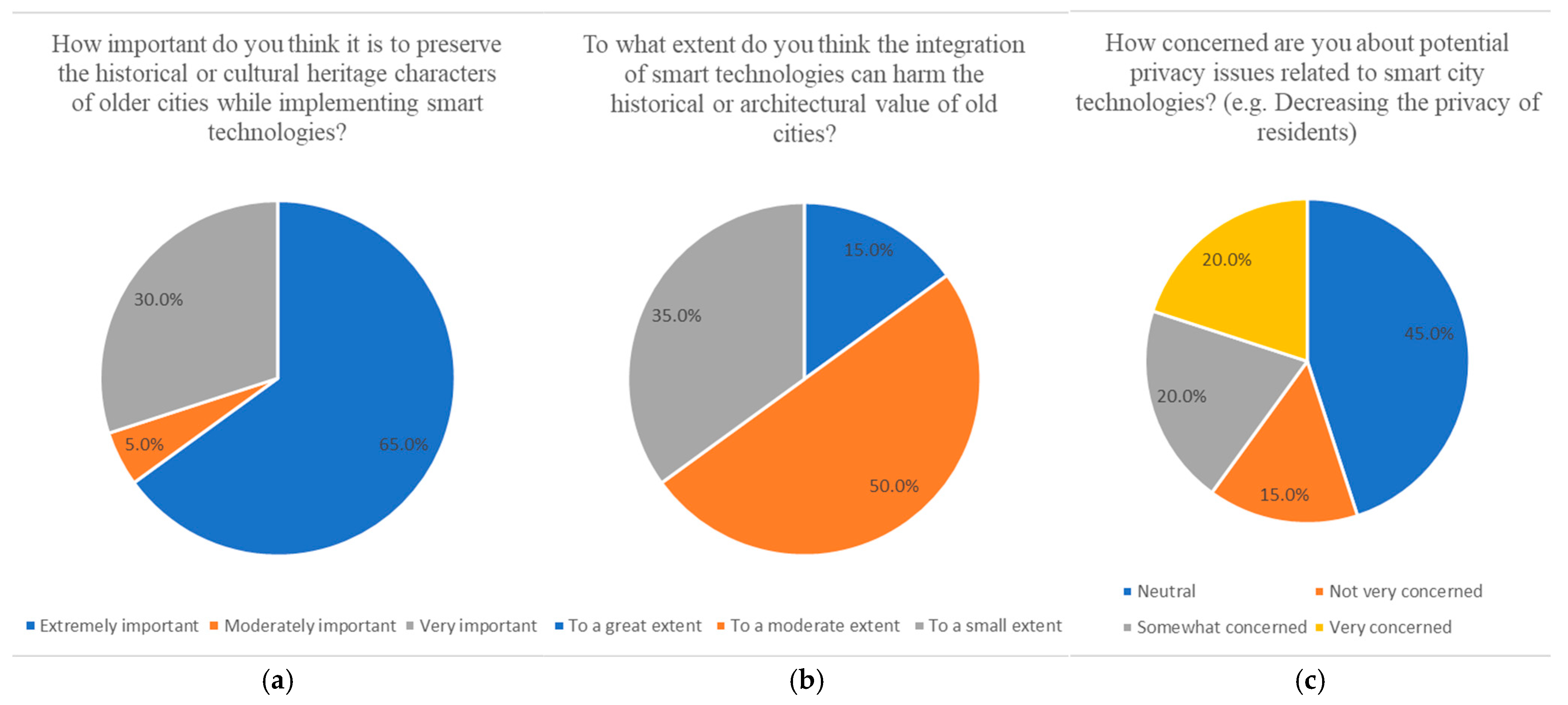
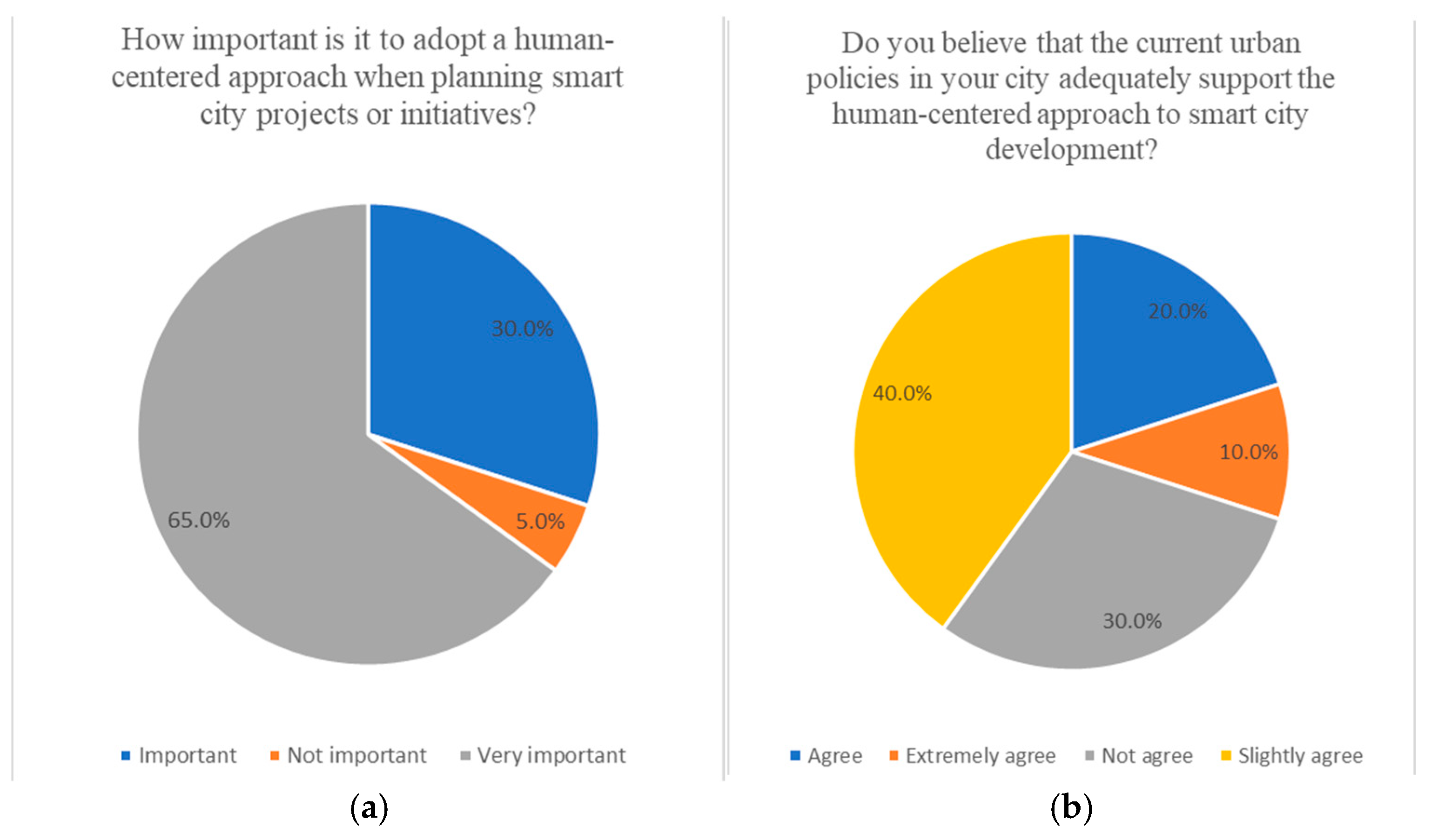
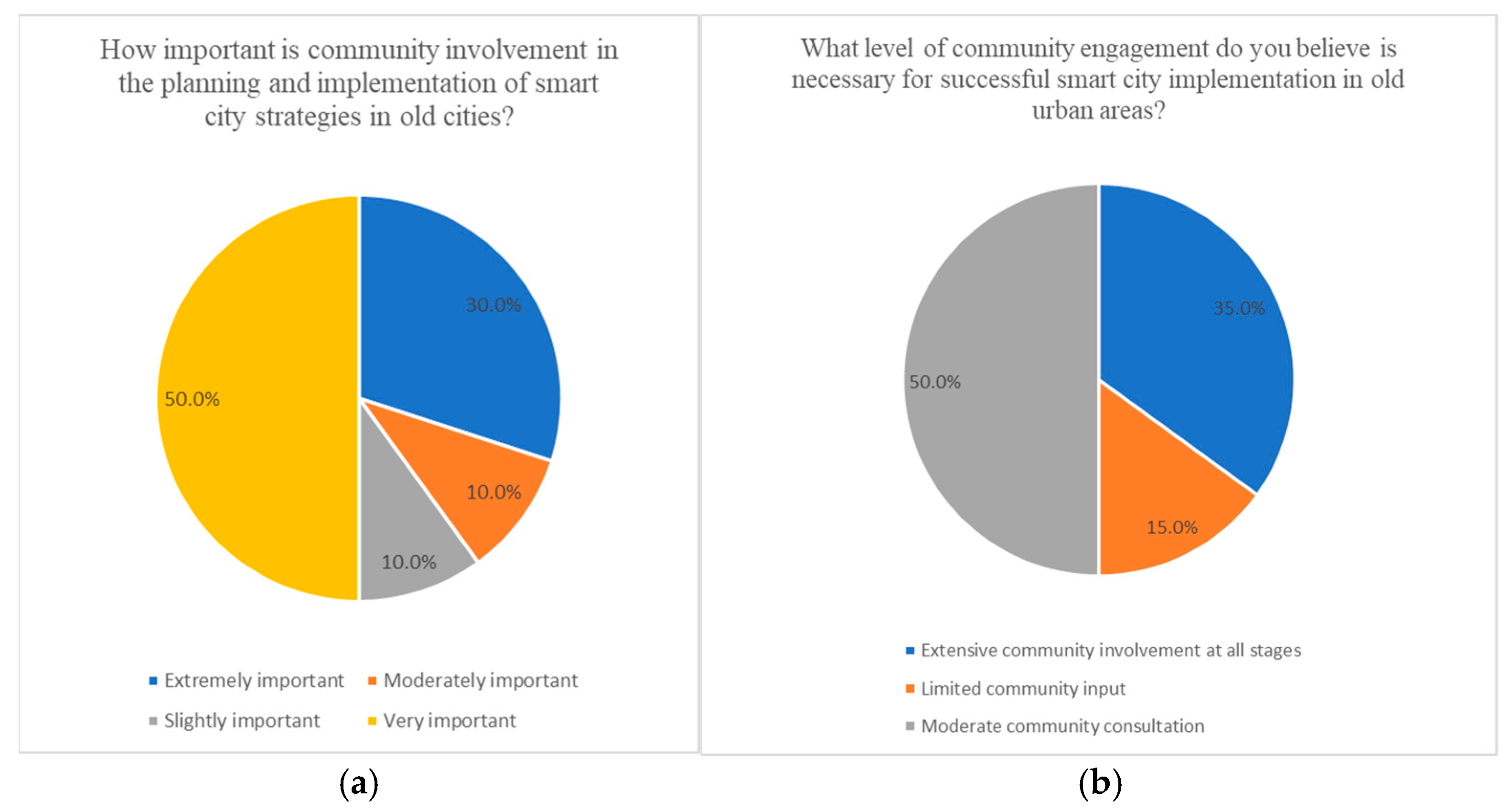
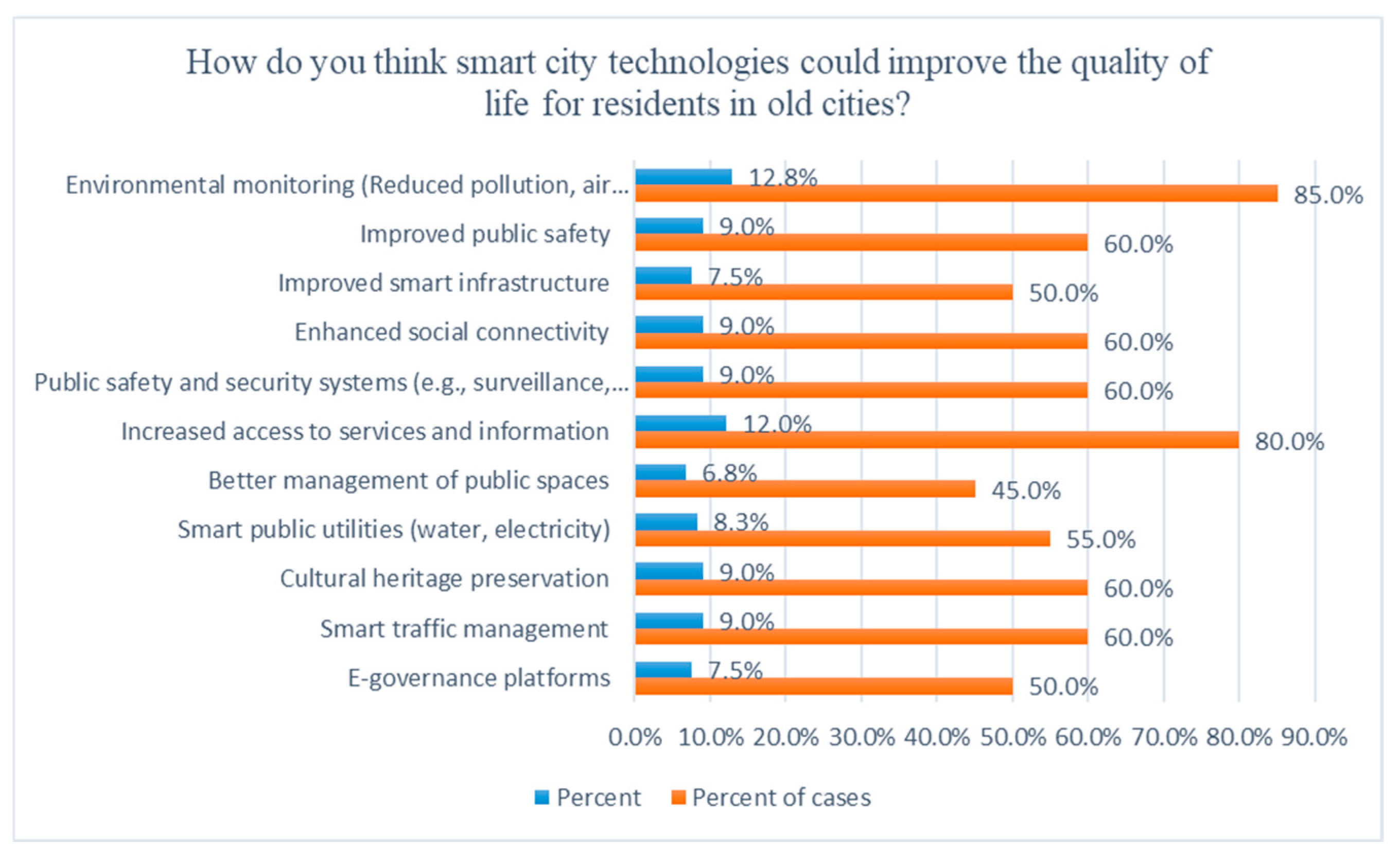
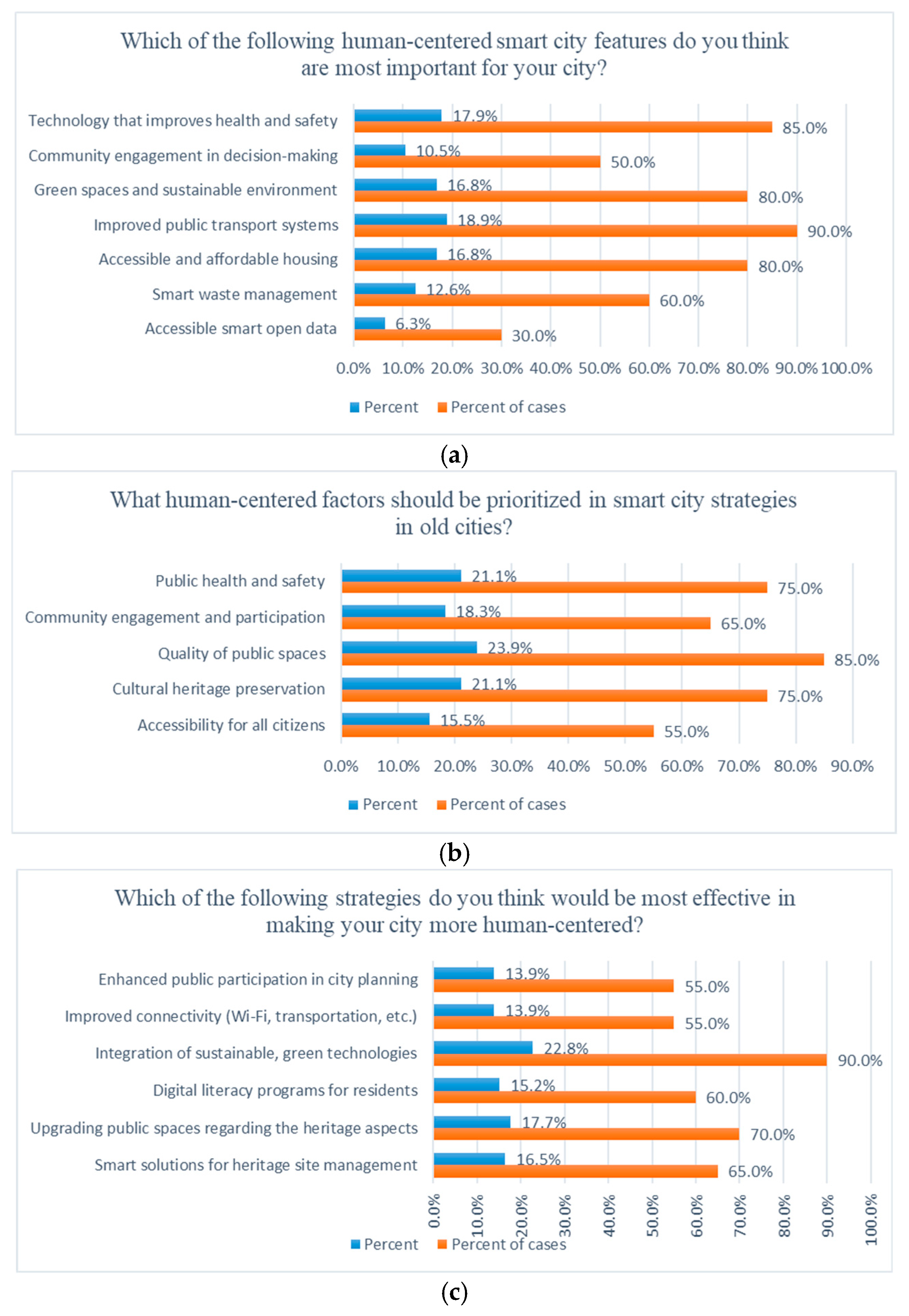
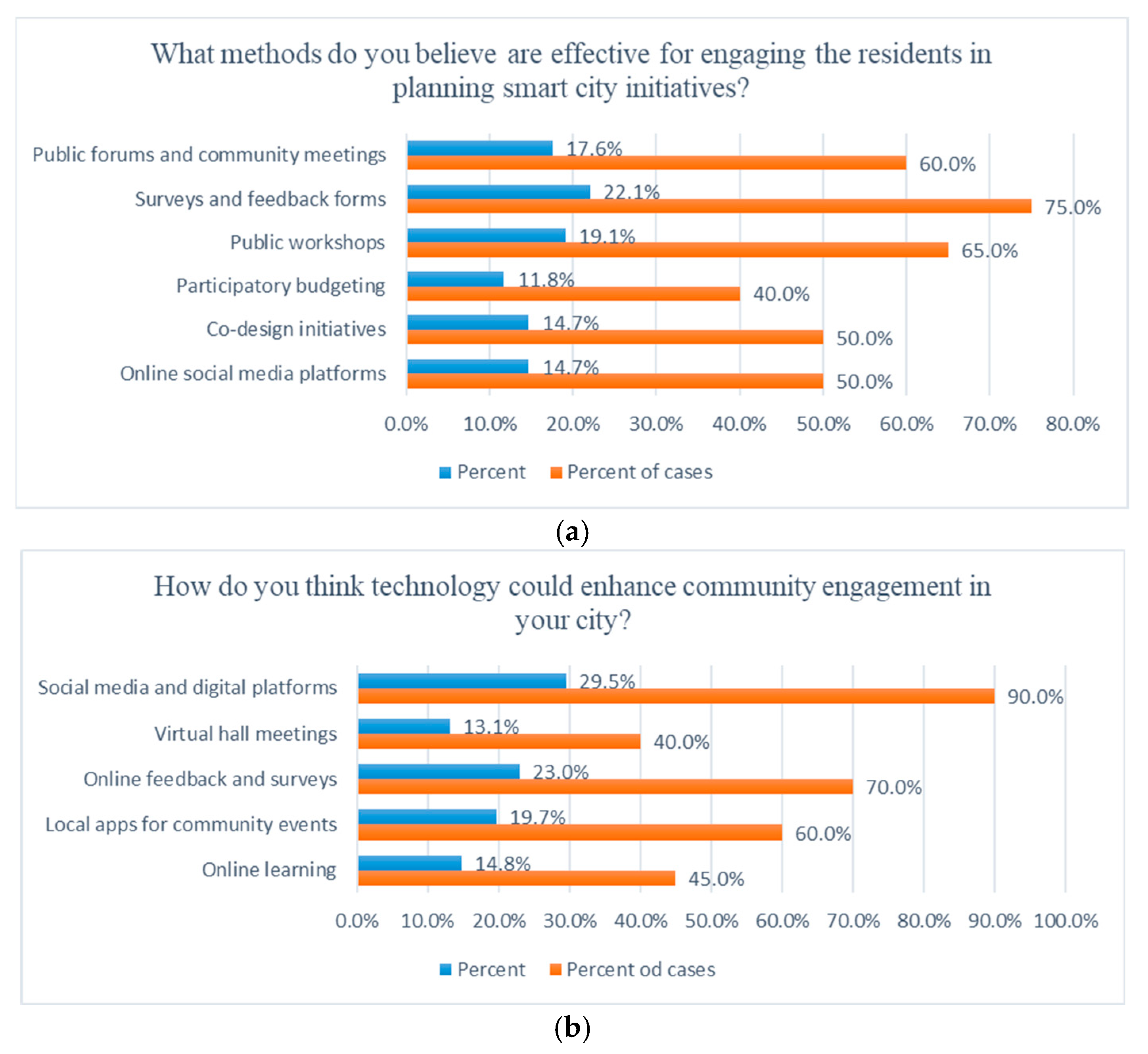
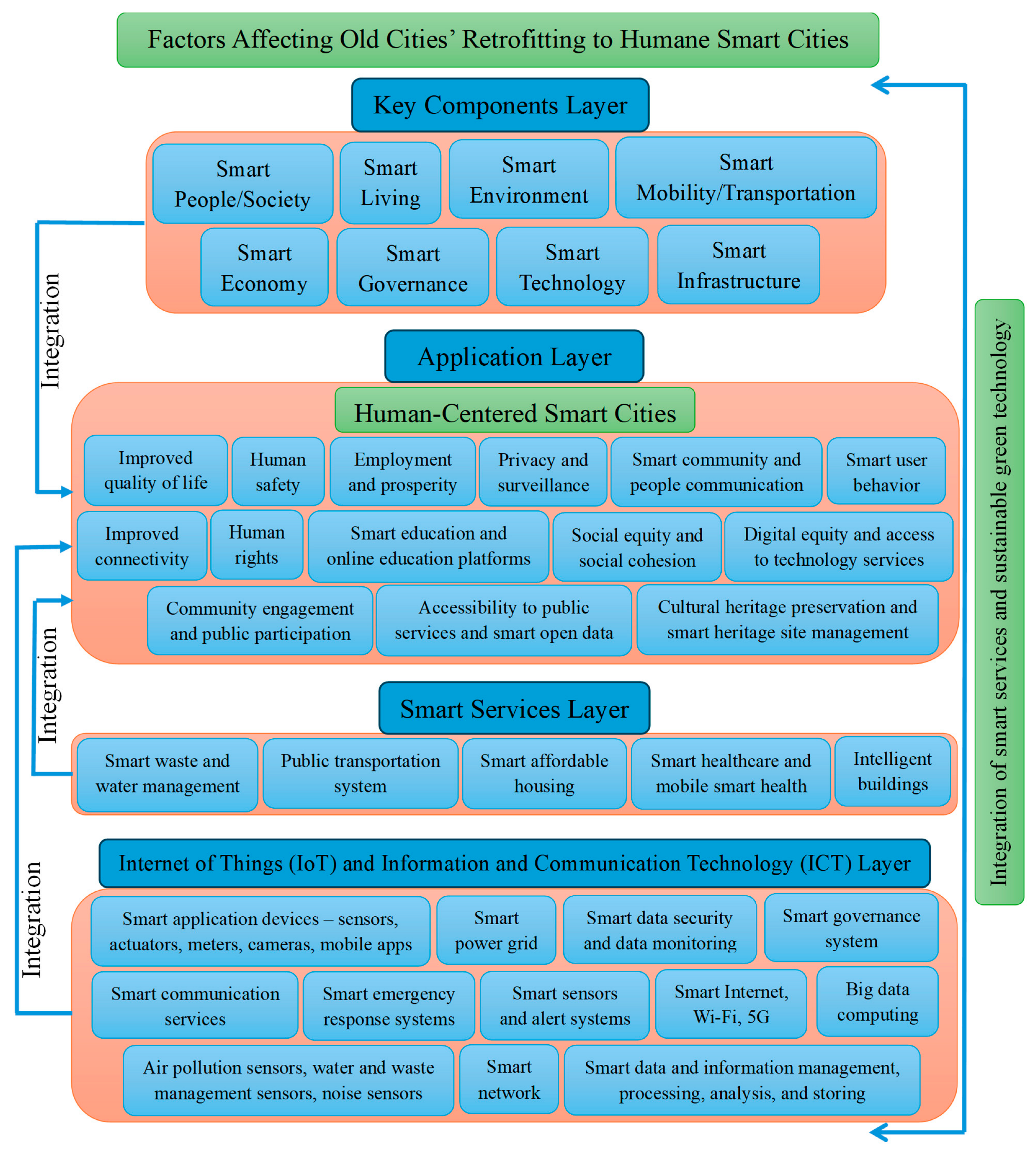
| Literature/Authors | Year | Smart City Definitions |
|---|---|---|
| Gracias, J.S. et al. [1] | 2023 |
|
| Patrão, C. et al. [8] | 2020 |
|
| Belli, L. et al. [9] | 2020 |
|
| González-Reverté, F. [10] | 2019 |
|
| Yigitcanlar, T. et al. [11] | 2018 |
|
| Schipper, R. P. J. and Silvius, A. J. G. [6] | 2018 |
|
| Kumar, T.M. and Dahiya, B. [12] | 2017 |
|
| Tekin Bilbil, E. [13] | 2017 |
|
| Depiné, A. et al. [14] | 2017 |
|
| Niaros, V. [15] | 2016 |
|
| Hara, M. et al. [7] | 2016 |
|
| Lara, A.P. et al. [16] | 2016 |
|
| Al-Nasrawi, S. et al. [17] | 2015 |
|
| Mora, L. and Bolici, R. [18] | 2015 |
|
| Piro, J. et al. [19] | 2014 |
|
| Cavada, M., Hunt, D., and Rogers, C. [20] | 2014 |
|
| Greco, I. and Bencardino, M. [21] | 2014 |
|
| Schaffers, S. et al. [22] | 2012 |
|
| Nam and Pardo [23] | 2011 |
|
| Zhao, J. [24] | 2011 |
|
| Fields | Terms | Definitions |
|---|---|---|
| Infrastructure and ICTs Adoption of economic and social development methods based on the supply of modern infrastructure, particularly in the widespread usage of ICTs [16]. | Ubiquitous city |
|
| Digital city |
| |
| Smart community |
| |
| Informational city |
| |
| Knowledge-based society and a creative economy Increasing competitiveness and aligning with the so-called knowledge economy, with an emphasis on fostering entrepreneurship, creativity, and innovation [16]. | Intelligent city |
|
| Creative city |
| |
| Knowledge city |
| |
| Innovative city |
|
| Fields | Terms | Definitions |
|---|---|---|
| Human infrastructure Investment in social and human capital; citizen participation in governance processes; and the formation of public–private partnerships to promote activities and initiatives [16]. | Human smart city |
|
| Humane city |
| |
| Learning city |
|
| Indicators/Dependent Variables | Possible Values/Independent Variables |
|---|---|
| Smart functionality and smart devices—Information and Communication Technologies (ICTs) and Internet of Things (IoT) | The integration of smart devices involves technological applications, such as; lighting, air conditioning control (HVAC systems), heat, and temperature-sensitive sensors, smart parking, weather tracking, environmental pollution, security systems, digital camera systems, and the detection of energy or water shortages. |
| Using smart computing technology and network technologies in healthcare, education, and transportation. | |
| Sensors and actuators, monitoring, and smart meters. | |
| Automated control devices. | |
| Improved quality of life—improved sustainability efficiency | Smart infrastructure services. |
| Water resource management. | |
| Healthcare and education. | |
| Environmental sensors. | |
| Waste management. | |
| Smart energy—energy efficiency. | |
| Smart mobility and transportation. | |
| The integration of information, the environment, technical aspects, people, and social aspects. | |
| Using new technologies to connect people and information to produce a sustainable, greener city. | |
| Enhancing life quality through the interaction between urban technologies and knowledge-based activities, and integrating smart technologies into urban design. | |
| People’s behavior and human rights | Using artificial intelligence for monitoring people’s behavior and tracking human rights in cyberspace. |
| Intelligent surveillance. | |
| Online citizens’ engagement and multi-level collaboration (public—local—private). | |
| Using smart computing technology improves public safety and security. | |
| Digital equity and access to technology | Networking and communication. |
| Software and public platforms. | |
| Cloud computing. | |
| The interrelation between users and technology. | |
| Lowering digital inequity and increasing digital capacity. | |
| High-speed internet. | |
| Innovation and creativity | Artificial intelligence. |
| Improved urban spatial intelligence (hardware, software, programming technologies, information, and communication). | |
| Data analysis and machine learning. | |
| Adopting innovative systems, communication, and information technologies in the local community. | |
| The integration between networks, databases, analytics, applications, and users. | |
| Decision-making innovation. |
| Indicators/Dependent Variables | Possible Values/Independent Variables |
|---|---|
| Education, learning, innovation, and awareness issues | Knowledge and smart education. |
| Developing learning environments. | |
| Enabling local skills and innovation. | |
| Human and social capital, as well as inventiveness. | |
| Raising citizens’ awareness, e.g., training courses. | |
| Strengthening communities and building capacities. | |
| Employment rate | Providing jobs and employment. |
| People-centered investment. | |
| Optimizing business processes, e.g., using smart integrated computing systems and network technology. | |
| Building capabilities, qualifications, and citizens’ skills. | |
| Healthcare | Providing smart health centers and e-health. |
| Emergency health quick response system. | |
| Participation | Citizens’ participation, social engagement, leadership, and decision-making in public life. |
| Promoting public participation in policymaking. | |
| Citizens’ engagement in the development of the city. | |
| People’s interaction in real and virtual spaces, involvement, and collaboration. | |
| Cooperation and collaboration between public institutions, the private sector, and voluntary organizations. | |
| People’s inequity, social inequity, poverty, human rights, and people’s behavior | Urban diversity and cultural mix. |
| Social cohesion and interaction. | |
| Digital equity and access to ICT connectivity. | |
| Freedom of expression. | |
| Enhancing cultural aspects. | |
| Using artificial intelligence to monitor people’s behavior and protect human rights in cyberspace. | |
| Urban violence, behavior, insecurity, data safety, privacy, and surveillance | Knowledge-based urban development. |
| Urban security, including monitoring, alarm systems, and cameras. | |
| Enhanced access to urban mobility. | |
| Establishing digital strategies that are human-centered, privacy-enhanced, and rights-preserving. | |
| Communication | People’s interactions and institutions’ collaboration. |
| Information and Communication Technology (ICT) connectivity. | |
| Intelligent communication network. | |
| Digital equity: access to technological services | People-centered digitalization. |
| Using Information and Communication Technology and the Internet of Things. | |
| The collaboration between residents, businesses, and governmental organizations through digital platforms. |
| Indicators/Dependent Variables | Possible Values/Independent Variables |
|---|---|
| Quality of life (livability) | Life enrichment (home, healthcare, community, public spaces, and education). |
| The interaction between the information environment and people. | |
| The interaction between technical, environmental, and social aspects. | |
| Personal safety. | |
| Social cohesion and cooperation. | |
| Affordable housing | Smart buildings and housing. |
| Creating a range of housing opportunities and options. | |
| Cultural issues | Enhancing cultural facilities and tourism alternatives. |
| Socio-cultural variety. | |
| Availability of cultural and educational facilities and tourism attractions. | |
| Safety and security, accidents, crimes, and violence | Smart emergency response. |
| Personal monitoring. | |
| Smart public lighting. | |
| Smart surveillance systems: sensors, cameras, and other devices. | |
| Public services and administration (public safety, food safety, traffic safety, and environmental protection). | |
| Healthcare support | Enhancing the smart healthcare system—connected by a smart network. |
| Green health facilities. | |
| Emergency management. | |
| Access to public services | Availability of social services. |
| Equitable access to services. | |
| Online services. | |
| Smart apps and networking. | |
| Access to community services. | |
| Intelligent, real-time sensing and online services | GPS tracking sensors. |
| Linking and sharing information through GIS and GPS. | |
| Using ICT and IoT. | |
| Using smart computing technologies represented by hardware, software, and networks. | |
| The integration of technological, social, and scientific solutions. | |
| Diversification and social cohesion | The adoption of mixed land use, people’s proximity, and suitable interaction spaces. |
| Social cooperation. | |
| Emphasizing spatial proximity and promoting a sustainable community. | |
| Working issues | Empowering citizens with digital options for working remotely. |
| Easy routes and reduced traffic. | |
| Urban sustainability | Establishing walkable residential neighborhoods that depend on pedestrian movement. |
| Preserving open spaces, agricultural land, and natural beauty. | |
| Knowledge-based urban development. | |
| Inclusive, resilient, efficient, livable, functional, equitable, and affluent places and a safer city. | |
| City attractiveness | Enhancement of neighborhood identity. |
| Promoting environmental attractiveness. | |
| Encouraging attractive communities and a sense of place. | |
| Prosperity—poverty | Social equity and inclusion. |
| Promoting socio-economic development. | |
| Reducing fuel poverty by using clean energy. | |
| Increasing productivity and utilizing resources. |
| S. | Categorization of Planning Areas of The Buffer Zone | Conditions and Regulations |
|---|---|---|
| 1. | Conservation Areas (CA) | Areas with a high degree of heritage value and a high level of protection and conservation. |
| 2. | Transitional Areas (TR) | Historic areas, but with some modern buildings. Located between the conservation area and the modern building area. |
| 3. | Reconfiguration Areas (RE) | Groups of modern buildings form the edge of the historic preservation area. |
| 4. | Urban Corridors (UC) | Areas with intense commercial concentration. They are located along major radial roads and ring roads. |
| 5. | Consolidation Areas (CO) | Areas that aim to enhance the existing classification of buildings and urban structures. Characterized by low-density residential use, and new uses, such as facilities and civil services, can be introduced. |
| 6. | New Courtyard Home Development Areas (NC) | Areas that aim to preserve the classification of courtyard houses. |
| 7. | Renewal Areas (RA) | Areas that aim to revive or redevelop parts of the building fabric. They are characterized by a low-quality built environment, such as abandoned land or uses that conflict with the surrounding environment. |
| Planning Area | Building Form Parameters | ||||||
|---|---|---|---|---|---|---|---|
| Maximum Building Height | Building Typology | Plot Area and Maximum Plot Coverage | Building Setback | Value and Construction Condition | Standard of Living | ||
| Consolidation Area | CO1 (Al-Minara and Al-Mustawfi) | 3 stories (12 m), 1 underground | Detached typologies, except for the following:
|
| Front: 2 m Side: 1.5 m Back in is not compulsory Third-floor recess required | High structural value and good condition | High standard of living |
| CO2 (Al-Minara, Al-Mustawfi, and North Khanqa) | 3 stories (12 m), 1 underground | Attached, detached, or semi-detached (optional) with front setbacks. If the plot has a triangular shape and two main facades, no front setback is required. |
| Front: 2 m Side (if applicable): 1.5 m Back in is not compulsory Third-floor recess required | Medium structural value and fair structural condition | Medium standard of living | |
| CO3 (Al-Mustawfi and North Khanqa) | 3 stories (12 m), 1 underground | Attached or courtyard houses required. |
| No front or side setback permitted Third-floor recess required | Poor structural value and poor structural condition | Poor standard of living | |
| CO4A (Al-Minara) | 2 stories (8 m), 1 underground | Attached, detached, or semi-detached (optional) with front setback. |
| Front: 2 m Side (if applicable) 1.5 m Back in is not compulsory | Very poor structural value and poor structural condition | Poor standard of living | |
| CO4B (Al-Minara) | 2 stories (8 m), 1 or 2 underground | Free-standing volumes. |
| Front setbacks are a minimum of 6 m | Very poor structural value and poor structural condition | Poor standard of living | |
| S. | Attribute | Minimum | Average | Maximum |
|---|---|---|---|---|
| 1. | Node Count | 20,726 | 20,726 | 20,726 |
| 2. | Line Length | 0.00123491 | 0.469857 | 3.57853 |
| 3. | Local Integration | 1.23104 | 2.60484 | 4.40888 |
| 4. | Global Integration | 1.14929 | 5.34058 | 8.30463 |
| 5. | Total Local Connectivity | 128 | 690,945 | 2.26781 × 106 |
| 6. | Global Connectivity | 3 | 174.821 | 1135 |
| 7. | Control | 0.024499 | 1 | 3.5302 |
| 8. | Controllability | 0.0223642 | 0.19265 | 0.714286 |
| 9. | Local Choice | 0 | 4522.47 | 251792 |
| 10. | Global Choice | 0 | 96420.4 | 1.06002 × 107 |
| 11. | Local Mean Depth | 1.85714 | 2.60086 | 2.92683 |
| 12. | Global Mean Depth | 3.6662 | 5.65237 | 10.5488 |
| 13. | Local Total Depth | 13 | 7357.34 | 24,690 |
| 14. | Global Total Depth | 75,982 | 117,145 | 218,624 |
| Hypothesis | Items | N | Mean | Std. Deviation | Std. Error Mean | t-test | p-value |
|---|---|---|---|---|---|---|---|
| H1 | How important is it to adopt a human-centered approach when planning smart city projects or initiatives? | 20 | 4.55 | 0.759 | 0.170 | 9.131 | 0.000 ** |
| H2 | How important do you think it is to ensure that smart city technologies are accessible to all residents, including the elderly and disadvantaged populations? | 20 | 4.00 | 0.918 | 0.205 | 4.873 | 0.000 ** |
| H2 | To what extent do you think the integration of smart technologies can harm the historical or architectural value of old cities? | 20 | 3.80 | 0.696 | 0.156 | 5.141 | 0.000 ** |
| H1 | Do you believe that the current urban policies in your city adequately support the human-centered approach to smart city development? | 20 | 3.10 | 0.968 | 0.216 | 0.462 | 0.649 |
| H1 | How optimistic are you about the potential for implementing human-centered smart city strategies in your old city? | 20 | 3.65 | 0.745 | 0.167 | 3.901 | <0.001 ** |
| Hypothesis | Items | N | Mean | Std. Deviation | Std. Error Mean | t-test | p-value |
|---|---|---|---|---|---|---|---|
| H1 | What level of community engagement do you believe is necessary for successful smart city implementation in old urban areas? | 20 | 3.20 | 0.696 | 0.156 | 4.499 | <0.001 ** |
Disclaimer/Publisher’s Note: The statements, opinions and data contained in all publications are solely those of the individual author(s) and contributor(s) and not of MDPI and/or the editor(s). MDPI and/or the editor(s) disclaim responsibility for any injury to people or property resulting from any ideas, methods, instructions or products referred to in the content. |
© 2025 by the authors. Licensee MDPI, Basel, Switzerland. This article is an open access article distributed under the terms and conditions of the Creative Commons Attribution (CC BY) license (https://creativecommons.org/licenses/by/4.0/).
Share and Cite
Ibrahim, A.F.; Husein, H.A. Building an Analytical Human-Centered Conceptual Framework Model for Integrating Smart Technology to Retrofit Traditional Cities into Smart Cities. Buildings 2025, 15, 3597. https://doi.org/10.3390/buildings15193597
Ibrahim AF, Husein HA. Building an Analytical Human-Centered Conceptual Framework Model for Integrating Smart Technology to Retrofit Traditional Cities into Smart Cities. Buildings. 2025; 15(19):3597. https://doi.org/10.3390/buildings15193597
Chicago/Turabian StyleIbrahim, Alhan F., and Husein A. Husein. 2025. "Building an Analytical Human-Centered Conceptual Framework Model for Integrating Smart Technology to Retrofit Traditional Cities into Smart Cities" Buildings 15, no. 19: 3597. https://doi.org/10.3390/buildings15193597
APA StyleIbrahim, A. F., & Husein, H. A. (2025). Building an Analytical Human-Centered Conceptual Framework Model for Integrating Smart Technology to Retrofit Traditional Cities into Smart Cities. Buildings, 15(19), 3597. https://doi.org/10.3390/buildings15193597







